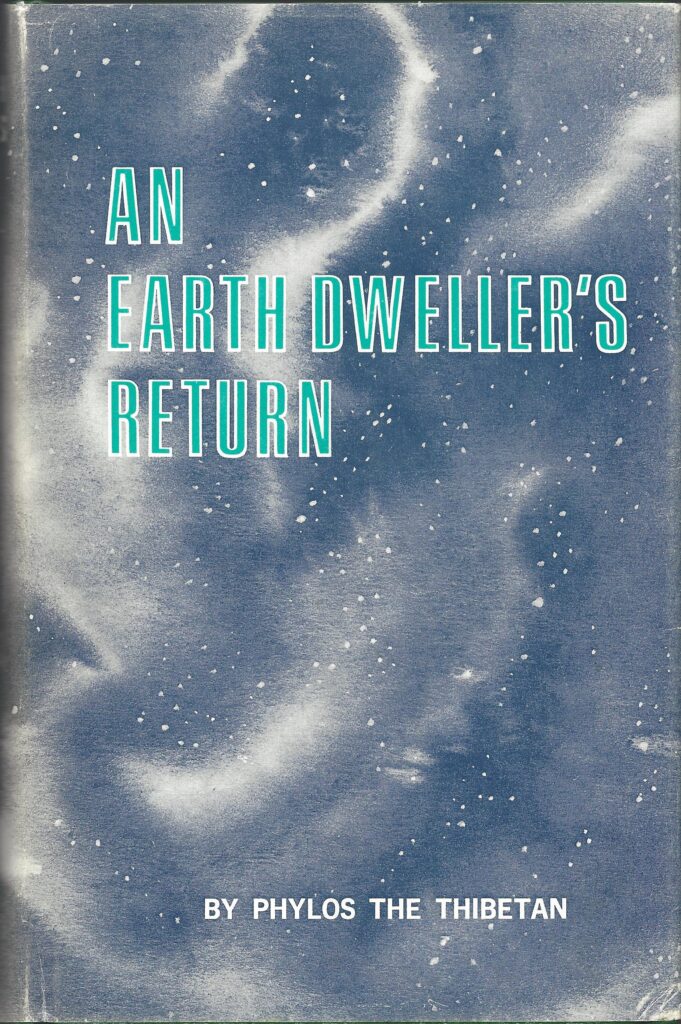Encyclopedia of Medical Astrology
Encyclopedia of Medical Astrology by H.L. Cornell, M.D. Publication: 1972 Samuel Weiser Publishing. Considered one of the most valuable works on astrology and medicine ever written. It’s presented in a dictionary format, with an exhaustive alphabetical listing of nearly every imaginable disease and symptom, diagnosed from an astrological point of view. Hundreds of useful hints, from chiropractic to rules for surgery, diet, planetary hours, colors, days of the week, weather and much more. Indexed and cross-referenced.
Henri Cartier-Bresson ~ In India
Shri Sai Satcharitra : The Wonderful Life and Teachings of Sai Baba
The Handy Prasanthi Pocket Book
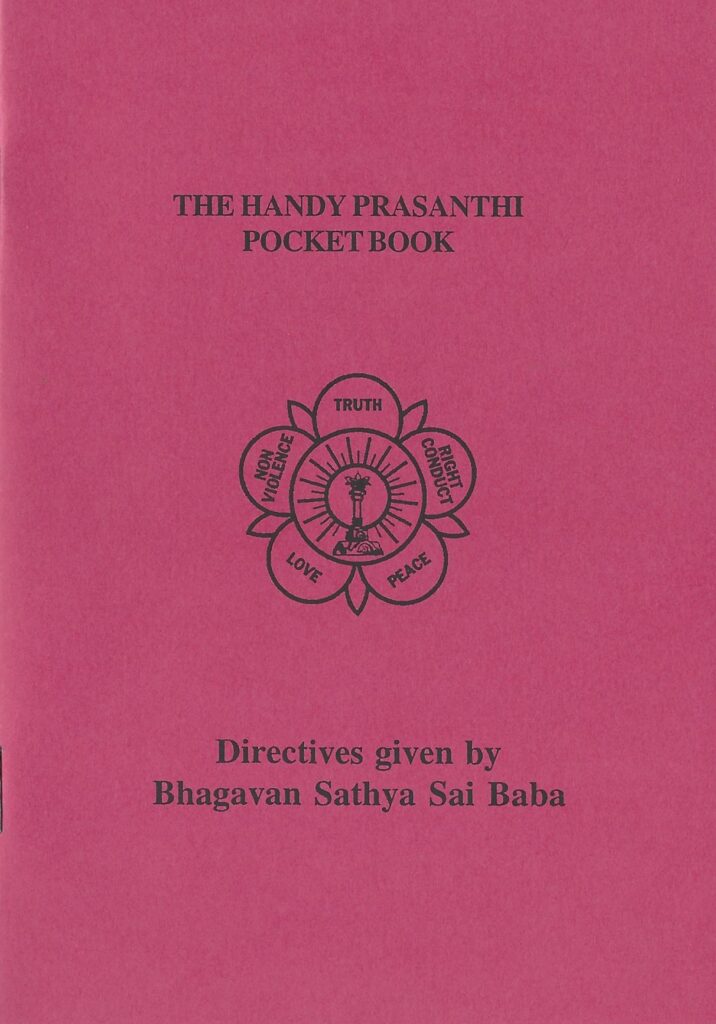
Ramana Maharshi
Astral City: Nosso Lar: Life in the Spirit World (Portuguese: Nosso Lar), also known as Astral City, is a novel by the Brazilian spiritist medium Francisco Cândido Xavier
The Most Holy Trinosophia : La Très Sainte Trinosophie

Alchemy: Saint Germain
The Apparitions of Garabandal: F. Sanchez-Ventura Y Pascal
Originally published in Spain (1966) under the title LAS APARICIONES NO SON UN MITO el interrogante de Garabandal
A Dweller on Two Planets
An Earth Dweller’s Return
The 12th Planet
The 12th Planet is the first book in Zecharia Sitchin’s prophetic Earth Chronicles series – a revolutionary body of work that offers indisputable documentary proof of humanity’s extraterrestrial forefathers. Travelers from the stars, they arrived eons ago, and planted the genetic seed that would ultimately blossom into a remarkable species… called Man.
The Three Days In The Temple
Divine Word Foundation – New Revelation teachings
The three day scene in The Temple we read in the gospel of Luke is about the twelve-year-old Jesus in the temple in Jerusalem. This book, Three Days In The Temple, describes in detail what happened in those three days when Jesus astonished and distressed the Pharisees and scribes with his wise speeches… “I say to you: This scene was foreseen by Me from eternity …My name is Jesus Emanuel, and My Spirit is Jehovah Zebaoth.”
Krishnamacharya’s Yogasanagalu
Yoga Makaranda
Under the king’s generous patronage, Krishnamacharya also authored what would be his magnum opus, the Yoga Makaranda, a two-volume encyclopedia on yoga in 1934.
India Today ~ Special Edition, September 2012 ~ Mata Amritanandamayi
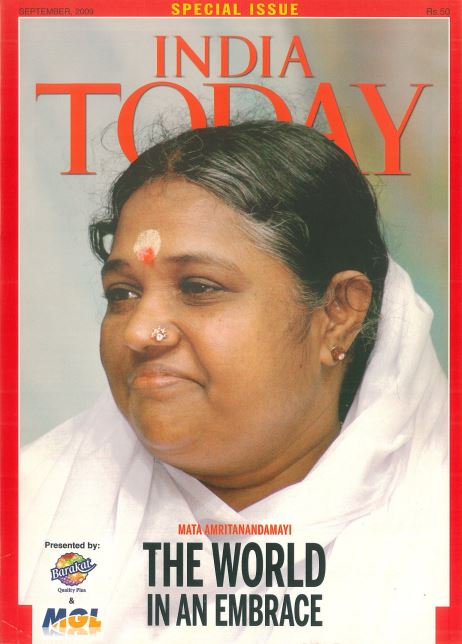
Beyond Biofeedback: Elmer and Alyce Green
The Amazing Secrets of the Yogi: Charles F. Haanel
1937 FIRST EDITION
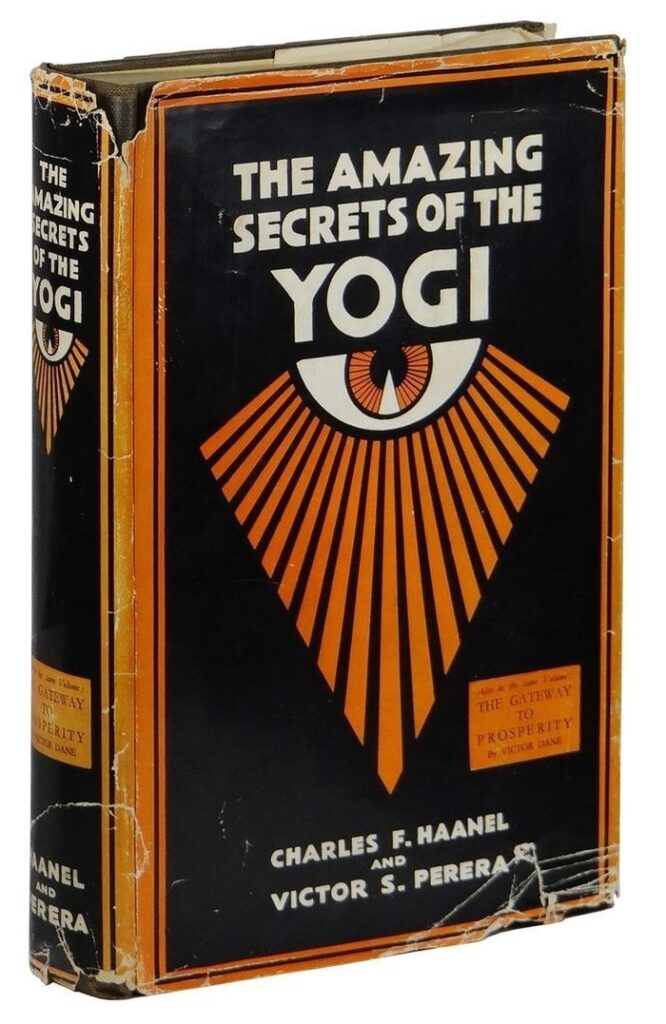
“In The Amazing Secrets of the Yogi I have embodied many valuable secrets, which have been collected with great care from the treasured wisdom of Ancient India.”
“These secrets if put into daily practice will bring you added health, greater success and unbounded happiness. They will prove to be a “guide, philosopher and friend” and will serve you well in times of trouble, difficulty or disease. In fact you will soon come to regard them as the greatest boon that has ever come into your life.” Charles Francis Haanel was an American New Thought author and a businessman. He is best known for his contributions to the New Thought Movement through his book The Master Key System.
Download:
https://www.academia.edu/5824247/The_Amazing_Secrets_of_the_Yogi
Early Christian Writings
Early Christian Writings is the most complete collection of Christian texts before the Council of Nicaea in 325 AD. The site provides translations and commentary for these sources, including the New Testament, Apocrypha, Gnostics, Church Fathers, and some non-Christian references. The “Early Christian Writings: New Testament, Apocrypha, Gnostics, Church Fathers.”
https://www.earlychristianwritings.com/
Guide to the Best Ashrams in India: Marco Pino’s Personal Experience (UPDATED 2020)
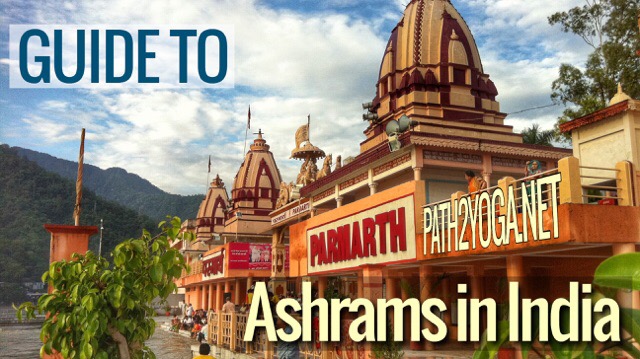
If you are searching for the best ashrams in India then this guide may be for you. Marco Pino wrote this ashram list based on the 15 ashrams and yoga retreats in India that he has personally visited during his own yoga journey. You can read in detail about his personal experience and the offerings found in the ashrams.
Download:
https://www.path2yoga.net/2012/11/guide-to-ashrams-in-india-yoga-retreats.html
The Ayurvedic Pharmacopoeia of India
Download:
http://ayurvedanofeminino.blogspot.com/p/free-ebooks.html?m=1
Download:
https://naturalingredient.org/wp/wp-content/uploads/API-Vol-1.pdf
https://naturalingredient.org/wp/wp-content/uploads/API-Vol-2.pdf
https://naturalingredient.org/wp/wp-content/uploads/API-Vol-3.pdf
https://naturalingredient.org/wp/wp-content/uploads/API-Vol-4.pdf
https://naturalingredient.org/wp/wp-content/uploads/API-Vol-5.pdf
https://naturalingredient.org/wp/wp-content/uploads/API-Vol-6.pdf
https://naturalingredient.org/wp/wp-content/uploads/API-Vol-7.pdf
Download:
The Siddha Pharmacopoeia of India
Download:
https://nischennai.org/uploaded/pdf/THE%20SIDDHA%20PHARMACOPOEIA%20OF%20INDIA.pdf
The Bible in India: Louis Jacolliot

The correspondence between Christ and Christna/Krishna has been noted by numerous scholars including the late Tom Harpur, former U/T prof of Greek and New Testament and theologian, and Louis Jacolliot in his 1876 book: The Bible in India. Jacolliot was a French jurist in India during the time France held colonies in India. He studied Sanskrit and the Indian religions.
Jacolliot claims with good support, relying especially on how Sanskrit names morphed into Egyptian, Greek, Latin and Hebrew, that the religions of Egypt, Greece, Rome/Italy and the Abrahmic religions plagiarized the Vedic religion – Hinduism. Manu (the primeval MAN and ancient Law Giver of Indian origin; the word ‘man’ is derived from said Manu) morphed into Manes, Minos and Moses.
He also argues that it is Krishna’s teachings which Jesus studied and that he was assigned the “Christ” to reflect Christna/Krishna by the apostles/followers. He also queried why Jesus’ ministry began when he was age 30. He was most likely sudying ancient religions.
And, Noah’s flood is taken from the legend of Manu.
St Augustine (354-430 AD) said that what is called the Christian religion existed among the ancients.
The Adam and Eve story is out of Sri Lanka. Adam is derived from Sanskrit “Adima” meaning the ‘first’ or ‘original’ and Heva means ‘to complete’, so that Heva complements Adima who combined to be the first human ancestors.
Incidentally, a mountain peak in Sri Lanka is called “Adam’s Peak”, which early mariners used as a guide. Furthermore, there is a ‘bridge of rocks’ linking Sri Lanka with India. That bridge is called Adam’s Bridge. That bridge is said to have been made by Lord Ram (another earlier avatar) using an army of monkeys to help him get to Lanka to retrieve his wife Sita who was abducted by Ravana.
Another fact of interest which will support Jacolliot’s thesis is that there are two cities in Italy on opposing coasts, called Rome and Raveena, just as Rama and Ravana were opposites!
Two important points to note in the Adima-Heva (Adam-Eve) legend is that it is the MAN, Adima, who violated God’s instruction, NOT the woman, Eve, in the Abrahamic Bible and tradition is blamed as the prime actor of “Original Sin”. In fact, God was soft on Heva, promising that one of her female progeny would be the Mother of the ‘Redeemer’ (Christna/Krishna and other outars).
Louis Jacolliot deals with many more such as the ‘virgin’ birth of Jesus and Krishna and both were in danger of being killed by a tyrant king. Anyone not worried about their faith shaken should read his work, as am impartial observer.
Review by Veda Nath Mohabir
Download:
https://ia600301.us.archive.org/13/items/bibleinindiahind00jacorich/bibleinindiahind00jacorich.pdf
The New Unger’s Bible Dictionary
This has been one of the best‐selling Bible dictionaries on the market since its introduction almost 50 years ago. Now, this time-honoured classic is more valuable than ever. Packed with current scholarship, more than 67,000 entries are supplemented with detailed essays, colorful photography and maps, and dozens of charts and illustrations to enhance your understanding of God’s Word.
Download:
Dictionary of Deities and Demons in the Bible
The Dictionary of Deities and Demons in the Bible contains academic articles on the named gods, angels, and demons in the books of the Hebrew Bible, Septuagint and Apocrypha, as well as the New Testament and patristic literature.
Download:
Devatma Shakti: Swami Vishnu Tirtha

This book was originally published prior to 1923, and represents a reproduction of an important historical work, maintaining the same format as the original work. While some publishers have opted to apply OCR (optical character recognition) technology to the process, we believe this leads to sub-optimal results (frequent typographical errors, strange characters and confusing formatting) and does not adequately preserve the historical character of the original artifact. We believe this work is culturally important in its original archival form. While we strive to adequately clean and digitally enhance the original work, there are occasionally instances where imperfections such as blurred or missing pages, poor pictures or errant marks may have been introduced due to either the quality of the original work or the scanning process itself. Despite these occasional imperfections, we have brought it back into print as part of our ongoing global book preservation commitment, providing customers with access to the best possible historical reprints. We appreciate your understanding of these occasional imperfections, and sincerely hope you enjoy seeing the book in a format as close as possible to that intended by the original publisher.
Download:
https://b-ok.cc/book/6145724/b91f25
The Divine Life Society: Swami Sivananda: Download Books
Exploration in Tibet: Swami Pranavananda
An important record by the first Indian explorer of Tibet in the early 20th century.
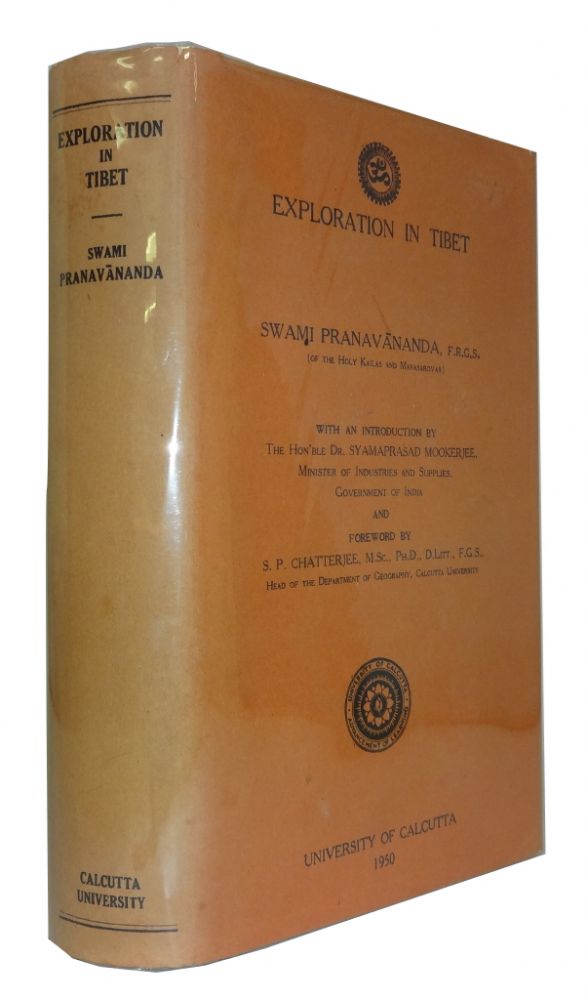
Foreword:
The book consists of two parts. In the first part, the author after giving a general description of the area deals with the various phenomena that he observed during the freezing and the melting of the lakes — Manasarovar and Rakshas Tal. The crevasse, locally known as mayur, along the edge of which blocks of ice are piled up, is a peculiar surface feature of Manasarovar when it freezes. The Swami is the first explorer who studied the lakes continuously during the whole of the winter and the early spring, and has given us a vivid and picturesque description of the changing surface features of the lakes during this period. His descriptions of the people and their mode of living, though brief, are no less interesting.
In the second part of the book, the author takes up the question of the sources of the four great rivers and attempts to tackle it thoroughly in an exhaustive manner. The problem of fixing the sources of rivers is a difficult one, especially in a region like Tibet, where rivers are continuously cutting back by headwater erosion. It requires a detailed and careful study before anything like a “ last word can be said on this point. I am glad to find that the Swami is not dogmatic in his assertions, far less egoistic. He examines systematically the different criteria which professional geographers usually apply in the case of the four great rivers, and arrives at the conclusion that it would be most reasonable and nearer the truth to accept the traditional sources. He draws the attention of the reader to certain inconsistencies in Dr. Sven Hedin’s treatment of the subject, though I am sure, that the Swami’s admiration and regard for Dr. Sven Hedin as an explorer and one of the greatest geographers, are in no way less than anybody else’s.
I am confident that this book will be widely appreciated both in India and abroad, and I hope that it will do much to start lively discussions on the four great Indian rivers, and to rivet the attention of geographers all the world over on this important problem — the sources of these rivers once again. Whatever may be the final outcome of such a searching enquiry, at this stage I cannot hut con- gratulate the author on his work which I am to concede is well-neigh an achievement, if it is borne in mind that he did all this single-handed, unaided by either the technical knowledge of a trained surveyor like Strachey or Ryder, or by the vast resources in men and money, like the great explorer Dr. Sven Hedin. I am certainly of opinion that his results would throw fresh light on the several problems relating to Tibetan geography and would usher in a new era when Indian geographers will once again take their rightful place amongst explorers of Tibet and the Himalayan regions.
Download:
http://ignca.gov.in/Asi_data/33681.pdf
Four Years in Tibet
Originally published in 1906, Four Years In Tibet follows the travels of Ahmad Shah through Tibet and Ladakh. A Christian missionary, Shah investigates claims made in the book “The Unknown Life of Jesus Christ” by Nikolai Notovich, which made claims that there is a lost gospel of Jesus’ life in India and Tibet. Aside from his investigation into Notovich’s claims, Shah makes observations of the Tibetan culture of the time.

Aside from his investigation into Notovich’s claims, Shah makes observations of the Tibetan culture of the time. Written more than a century ago, Shah provides an interesting look at life in Tibet, including its inhabitants, religion, burial customs, and marriage among other topics. Due to its age, the language used is occasionally dated. Excerpt from first chapter: “It was on the 20th of March 1894, a friend with whom I was staying at Bandar received a telegram from Ajmer to say that Mr. Andrews of America and Pandita Rama Bai wanted to see him at Agra the next day. It was already nine o’clock at night and there were only two hours before the train was to start. I determined to accompany my friend. We hastily packed for the journey, started at once and reached Jhansi the next morning where we changed for Agra. Unfortunately it was the season for some great Kind pilgrimage and the trains were crammed from roof to-floor with passengers who were hastening on. We were to travel second class, but on that day there were no second class carriages provided, so we entered a first which was almost empty—there being in it only one gentleman who was engaged in perusing the columns of the great Indian daily the “Pioneer.” An interesting story of a European cremation was going the round of the papers at that time. A civilian of note in Meerut had willed to-be cremated instead of being, buried, and the ceremony, which had been performed, created a great sensation. A cremation is a very common thing in India. Every Hindu is cremated’. But for a European to be cremated on Indian soil is a rare event. Of course in France or in England no one would be startled by such a method of disposing of the dead; in those countries in fact we read of Christian, cremation as a Christian-rite. Both, of us were interested in the story and the Parsee gentleman having offered the paper to us, I read it through and then cast a glance over the advertisement column. My eye was attracted by the words: “ WANTED, a medical man of experience.” I was out of employment, but as my wife had just recovered from a long illness and was still at Banda for a change, I was not just then prepared to accept a post. But some how or other I thought it worthwhile just to try for it. I therefore, drafted an application while the train was in motion. I posted it at once, to see what would come of it. I thought there would be sufficient time to consider the matter before I received the reply.”
Download:
https://archive.org/details/fouryearsintibet00ahma
Glimpses of a Great Yogi by Prof. V Rangarajan

Yogi Ramsuratkumar blessed and guided aspiring souls to his Father, and even now, long after his mahasamadhi, he continues to
do so. But the Beggar Saint often boldly asserted that his real goal was in transforming individuals into perfect instruments of his
Father’s Work. We see that process of transformation play out in the 982 pages of this extraordinary story.
Download:
https://yogiramsuratkumarblog.files.wordpress.com/2018/04/glimpses-of-a-great-yogi-complete1.pdf
Preface:
https://yogiramsuratkumarblog.files.wordpress.com/2018/04/glimpses-of-a-great-yogi-preface-etc.pdf
Himalayan Handbook (1979) by Joydeep Sircar
An alphabetical listing of every Himalayan peak over 20,000′ with summaries of every attempt and ascent, with bibliographical references. A great reference for the smaller peaks.
Download:
http://pahar.in/?wpfb_dl=21068
History of Christianity In India by M.M. Ninan
In order to understand the History of Indian Christianity it is necessary to look into the environment in which Christianity developed in India. At the time of Jesus, India had a very flourishing civilization. It is normal for any country to claim a civilization, which started from the beginning of creation. But this is just a feature of nationalism. The reality is that there had always been civilizations in regions, which sustained life all over the world. Trade and relations between these civilizations molded the religious atmosphere of every civilization and country. India was no different.
Download:
http://www.talentshare.org/~mm9n/articles/pdf/History%20of%20%20Christianity%20in%20India.pdf
The Holy Mountain: Bhagwan Shri Hamsa
The Holy Mountain: Being the Story of a Pilgrimage to Lake Mãnas and of Initiation on Mount Kailãs in Tibet by Bhagwãn Shri Hamsa.

Bhagwan Shri Hamsa was born at Dhulia (India) on 15th June 1878. He was the younger son of Pandu Tatya Natekar, a well-known lawyer. As he lost his mother at the age of four, his father and elder brother took care of him. When Pandu Tatya learned from an astrologer that his son would become a yogi, he forbade him to read the Gita and found him a wife. He was married in his sixteenth year.
But one day sitting on the banks of the Indrayani at Dehu, he decided to renounce the world. He began to practice austerities: He read the Guru-Charitra, the Life of Dattatreya: Repeated the Gayatri Mantram, and only drank milk for his sole food.
After three and a half years of this life, he went on a pilgrimage encircling the whole of India, and visited once every year Mount Girnar, where the footsteps of Dattatreya are shown to pilgrims. Then in 1908 he made the pilgrimage to Mount Kailas, which he describes in this fascinating and mysterious book.
Download:
https://ia801601.us.archive.org/1/items/in.ernet.dli.2015.527960/2015.527960.The-holy.pdf
Indian Female Gurus in Contemporary Hinduism
A Study of Central Aspects and Expressions of Their Religious Leadership by Marie-Thérèse Charpentier
Download:
https://www.doria.fi/bitstream/handle/10024/66264/charpentier_marie.pdf?sequence=2&isAllowed=y
In The World’s Attic by Henrietta Sands Merrick
Published in 1931, Travel in the Himalayas. Introduction by Sir Francis Younghusband. 66 illustrations from photographs by the author; colour prints by Mrs. A.E. Berry.

“In Leh is the legend of Christ who is called Issa, and the monastery at Hemis holds precious documents fifteen hundred years old which tell of the days that He passed in Leh where he was joyously received and where He preached. There is also the tradition of the Biblical flood. And they have a national epic of which only a few manuscripts exist. Almost every village recites its own version of the story, for there are yet village bards in the land and they tell of His sons to be Kings of Earth and of the mission of His youngest Son to earth.” (Lady Henrietta S. Merrick, In the World’s Attic, p. 215 (1931).
Henrietta Sands Merrick (1879 – 1944) was an American traveller, the first woman to become a member of the Himalayan Club. She wrote In the World’s Attic (1931) (Ladakh), Spoken in Tibet (1933) (Sikkim to Gyantse), Caucus Race (1938) (a compilation of her Asian travels, along with a second journey to Ladakh from Srinagar and towards Kullu).
Download:
Journeys to Empire
Enlightenment, Imperialism, and the British Encounter with Tibet, 1774–1904 Illustrated Edition by Gordon T. Stewart
Download:
https://pahar.in/?wpfb_dl=24911
Kailash Journal. Pilgrimage in the Sacred Himalayas of Tibet: Swami Satchidananda
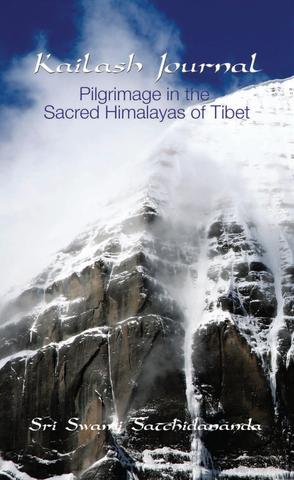
Published in 1984, the story of a rare physical experience and an even rarer spiritual one. It is the narrative told in Sri Swami Satchidananda’s own words, and illustrated with photographs he took of his pilgrimage to Holy Mount Kailash in Tibet, an 800 mile journey, on foot, to an altitude of 19,000 feet. Within the heart of this thrilling travelogue, however, lies another story: the quest for direct knowledge of God and the result of that quest.
In this book, we are invited to join a Yoga master in the daily events and practical details involved in a yatra, or pilgrimage – a rigorous and austere journey to Mount Kailash, the mountain that manifests the divine presence of Siva. In his own words and photographs, Swami Satchidananda recorded his journey to this great pilgrimage site. He undertook his pilgrimage in the earlier part of the 20th century, when, at age 44, he was already an accomplished yogi.
While many books have been compiled from transcripts of Swami Satchidananda’s talks, Kailash Journal is the only one that he actually wrote during his lifetime. And it is a diary that so clearly reveals the dedicated mood and attractive personality of this very special soul, as he brings us with him by means of his generous descriptions and photographic depictions of this journey. His simple but poignant and sober language sweetly expresses the spiritual sentiments and reflections that he had along the way.
Download:
https://lightinnerlight.com/wp-content/uploads/Complete-Kailash-Journal.pdf
Kundalini Yoga for the West: Swami Sivananda Radha
Download:
https://b-ok.cc/book/11842814/137dc2
Kailas-Mansarovar: Swami Pranavananda
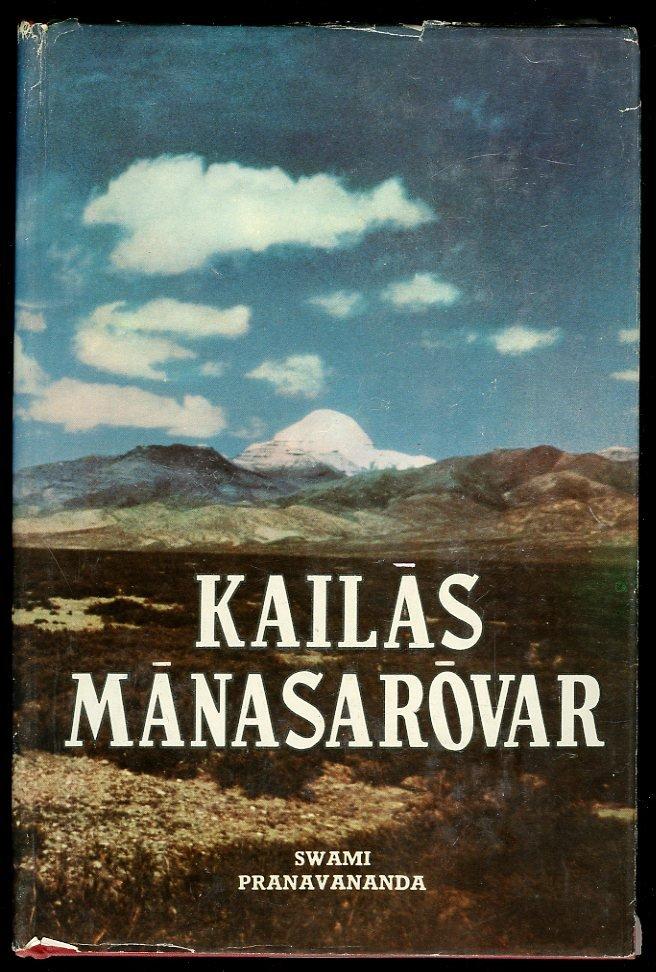
It is common knowledge that there has been no authoritative book on Kailas and Manasarovar published in English till 1938. The few guides that were available were either haphazard accounts and not systematically done, or compiled by persons who depended for their information on others, or incorporated hearsay material in their guides. This book is a description of the journey, the route, the stages and objects of interest on the way as well as the legend and the science. A period piece that is still contemporary.
The author had the privilege of travelling in 1928, for the first time, in Western Tibet on a visit to these Holy places. He went from Srinagar (Kashmir) through Ladakh, Gartok, Gyanima Mandi, round Kailas and Manasarovar, to Taklakot, Khocharnath, Chhakra Mandi, again to Gartok, and back to Rishikesh, by the Gunla-Niti pass.
In 1935 he undertook a second journey from Mukhuva (Gangotri) through Nilang by the Jelukhaga pass, Thuling, Mangnang, Dapa, Dongpu, Sibchilim, Gyanima Mandi, Kailas-Manasarovar, Chhakra Mandi, and back to Gaugotii by the Damjan-Niti pass. In 1936-37 and again in 1938 he travelled from Almora by the Lipu Lekh pass and returned by the same route. He had the privilege of staying for a full twelve-mouth in the Thugolho Monastery on the southern shores of Manasarovar for his spiritual sadhana. In the course of these travels he had opportunities of tracing the ‘Four Great Rivers’ of this Region, namely the Brahmapurta, the Indus, the Sutlej, and the Karnali, to their sources, of going over the frozen lake of Rakshas Tal from east to west and north to south, and landing on the two islands in it. He visited these regions again in 1939 by the Untadhura, Jayanti and Kungri-bingri passes.
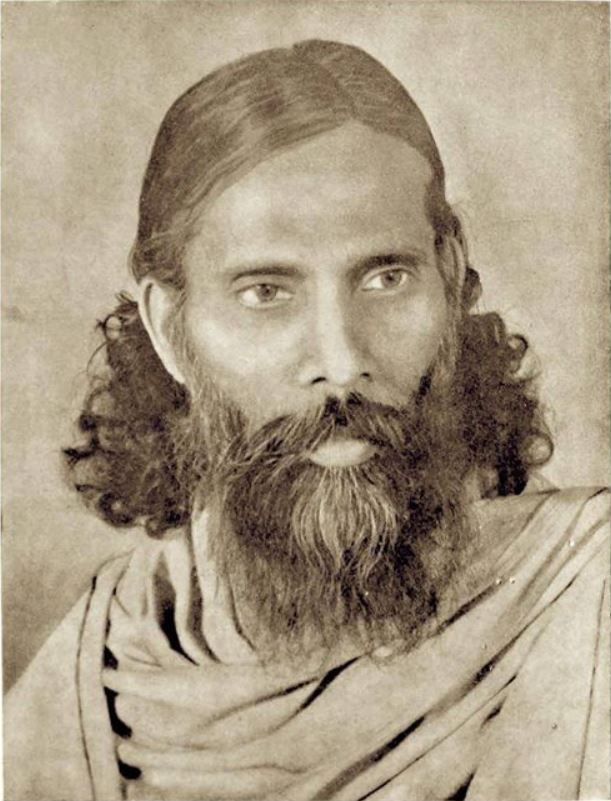
The author has been visiting these places regularly every year and staying there periods ranging from two to six months ; besides, he had occasion to spend a continuous sixteen-month, a second time in 1943-44 on the shores of the Holy Manasarovar at Thugolho. In all, he completed 23 parikramas or circumabulations of the Mount Kailas and 25 of. the Lake Manasarovar, of which 7 rounds were done in winter when the surface of the entire Lake was frozen. He collected some fossils from the Ganga Chhu and Thugolho in 1945 and from Bongza range in Central Tibet in 1947. In 1946, he visited the Deserted Cave-City of Pangtha.
He feels confident that with his extensive first-hand knowledge of these regions, he is in a position to render a minute and thorough-going account of these places with special emphasis on all important details likely to be of use and interest, to pilgrims and tourists. In his first book Pilgrim’s Companion to the Holy Kailas and Manasarovar, published in 1938, he endeavoured to present the material in some detail. Ever since the publication of the ‘Companion’ he has been trying to bring out a more comprehensive work on Kailas-Manasarovar Region, useful not only to the tourist but also of general interest to the student of geography. In fact, his book Kailas-Manasarovar, written in Hindi, was intended to be a comprehensive and authoritative volume on these two mystic places, held sacred by Hindus and Buddhists alike.
This book is a scholarly description of the geography, the stages of the journey and the flora and fauna. Moreover, the Swami also traced the sources of four major rivers during his journeys in Tibet – the Indus, the Ganges, the Brahmaputra and the Sutlej, in the process belying some of Sven Hedin’s prior claims to have been at the very spots. The Swami, in recognition is outstanding contributions to the geography of the region, was made a member by invitation of the Royal Geographical Society.
Download:
The Mystics, Ascetics, and Saints of India: John Campbell Oman
This book was first published in 1905. A study of Sadhuism, with an account of the Yogis, Sanyasis, Bairagis, and other strange Hindu sectarians .
Download:
https://archive.org/details/mysticsasceticss00oman
Naked They Pray: Pearce Gervis
Pearce Gervis first studied Law; then at Oxford he undertook his ground training in aeronautics and later on, gained his wings, was commissioned in the Royal Air Force. Next he entered the London Hospital Medical College of the University of London as a student.
After countless tours by ‘plane, train, car, on horseback and many miles on foot’, he has published This is Kashmir and Naked They Pray (1956), which have been acclaimed not only by the British Press but also by that of India.
Download:
https://archive.org/details/in.ernet.dli.2015.462305
Oral Testimonies on Sai Baba: Antonio Rigopoulos
Oral Testimonies on Sai Baba: As Gathered During a Field Research in Shirdi and Other Locales in October-November 1985.
Download:
https://edizionicafoscari.unive.it/media/pdf/books/978-88-6969-447-9/978-88-6969-447-9_9R4GWgW.pdf
Ramana Periya Puranam (Inner Journey of 75 Old Devotees): V Ganesan
V Ganesan, grand nephew of Ramana Maharshi. Up until the age of 14 he grew up in the presence and proximity of Bhagavan.
Download:
The Sacred Mountain:
The Sacred Mountain: Travellers and Pilgrims at Mount Kailas in Western Tibet, and the Great Universal Symbol of the Sacred Mountain by John Snelling.
Download:
https://pahar.in/?wpfb_dl=22588
Sanathana Sarathi ashram magazine (1958 – 2021) from Prasanthi Nilayam
Download:
https://saireflections.org/journals/PastEditions.php
Talmud Jmmanual

The Gurus Of India: Sujan Singh Uban
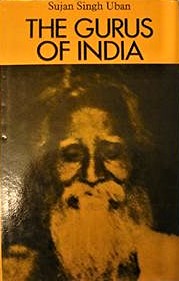
Major General Sujan Singh Uban (aka SS Uban) with Bangabandhu Sheikh Mujibur Rahman. The Chief Instructor of Mujib Bahini, a Legendary Figure during Bangladesh Liberation War of 1971. SS Uban, who commanded the 22nd Mountain Division as an artillery officer in Europe during World War II. Uban also went on to command a Long Range Desert Group Squadron (LRDS) in North Africa during the war.
Being a stalwart Military Officer, General Uban was a dedicated “Spiritualist.”
He was a disciple of different Spiritual Personalities Like, Swami Yogananda, Swami Sivananda, Sai Baba of Shirdi, Pir Vilayat Inayat Khan, Baba Sitaramdas Omkarnath, Anandamayi Ma, Sant Darshan Singh Ji, Sant Kirpal Singh Ji, Bhai Sahib Randhir Singh Ji and other Sikh Gurus.
He wrote The Gurus Of India where he mentions the Gurus he met.
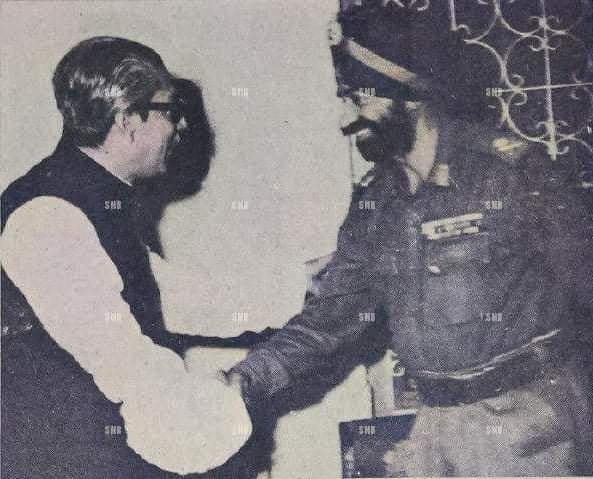
Download:
https://archive.org/details/in.ernet.dli.2015.220362
The Serpent of Paradise: the story of an Indian pilgrimage: Miguel Serrano
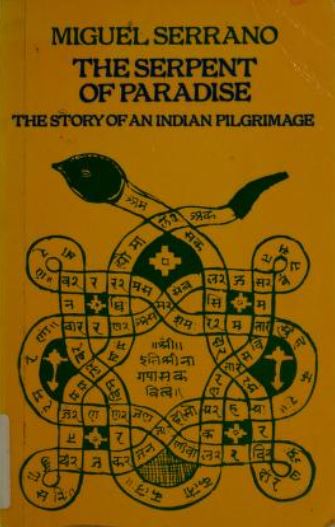
This work has been selected by scholars as being culturally important and is part of the knowledge base of civilization as we know it.
This work is in the public domain in the United States of America, and possibly other nations. Within the United States, you may freely copy and distribute this work, as no entity (individual or corporate) has a copyright on the body of the work.
Scholars believe that this work is important enough to be preserved, reproduced, and made generally available to the public. To ensure a quality reading experience, this work has been proofread and republished using a format that seamlessly blends the original graphical elements with text in an easy-to-read typeface.
The author recounts his experience in India, his contacts with swamis and gurus and his pilgrimage in the Himalayas. It covers the period (between the 50s and 60s of the 20th century) during which Miguel Serrano was Chile’s ambassador to that country. It is a search and amazing stories in an India full of symbolism with passages of extraordinary beauty as the child “lost in the temple”, the deep analysis of the sculptures of Khajuraho or his encounters with Krishnamurti.
Chilean diplomat and explorer, Miguel Joaquín Diego del Carmen Serrano Fernández, known as Miguel Serrano (10 September 1917 – 28 February 2009) was a writer, occultist, and fascist activist. A Nazi sympathiser in the late 1930s and early 1940s, he later became a prominent figure in the neo-Nazi movement as an exponent of Esoteric Hitlerism. He is one of the most important authors of esoteric Hitlerism, claiming that Aryan white people originated from an extra-terrestrial visitors. Serrano held various ambassadorial posts for Chile in 1953-1970. Originally embracing Marxism and writing for left-wing journals, he became quickly disillusioned with Communism. In 1939 he publicly himself with the Chilean party Vanguardia Popular Socialista and started writing for their journal Trabajo.

In 1953, Serrano joined the Chilean diplomatic corps and was stationed in India until 1962/3, where he took a keen interest in Hinduism and wrote several books. He was later made ambassador to Yugoslavia and then Austria, and while in Europe made contacts with various former National Socialists and other far-rightists living on the continent.
He considered India to be a source of great spiritual truths. While in India he visited many Hindu temples and searched for evidence of the secretive Brahmanical order into which F.K. had alleged initiation. In his role as a diplomat, he met various prominent figures, including Jawaharlal Nehru, Indira Gandhi, and the 14th Dalai Lama. It was while in India that he wrote and published two books: The Visits of the Queen of Sheba (1960), which had a preface by Jung, and The Serpent of Paradise (1963), which discussed his experiences in the country. Serrano had engaged in further correspondence with Jung between 1957 and 1961. In 1965 his book, C. J. Jung and Hermann Hesse: A Record of Two Friendships, was published.
Following Chile’s Election of a Marxist President, Salvador Allende, Serrano was dismissed from the diplomatic service in 1970. After Allende was ousted in a coup and Augusto Pinochet took power, Serrano returned to Chile in 1973. He became a prominent organiser in the Chilean neo-Nazi movement, holding annual celebrations of Hitler’s birthday, organising a neo-Nazi rally in Santiago, and producing a neo-Nazi political manifesto.
He wrote a trilogy of books on Hitler in which he outlined his view of the Nazi leader as an avatar. He remained in contact with neo-Nazis elsewhere in the world and gave interviews to various foreign far-right publications.
Download:
https://vdoc.pub/download/the-serpent-of-paradise-the-story-of-an-indian-pilgrimage-6g1fk3hvag80
The Soul of India: Amaury de Riencourt
Download:
https://ia801802.us.archive.org/22/items/in.gov.ignca.10363/10363_text.pdf
The Story of India: Michael Wood
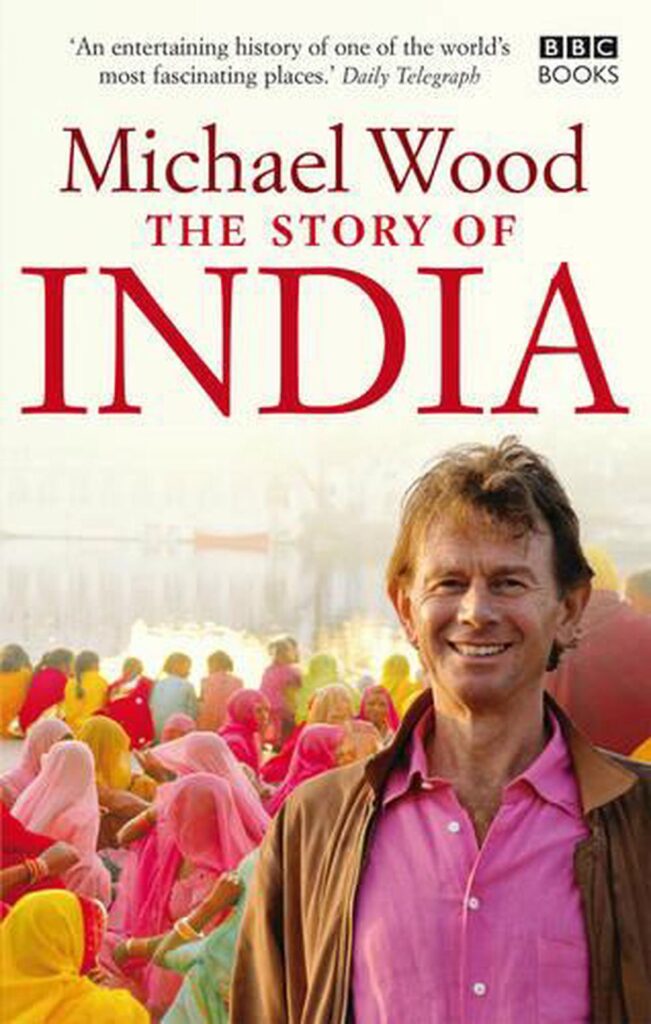
In The Story of India, Michael Wood weaves a spellbinding narrative out of the 10,000-year history of the subcontinent. Home today to more than a fifth of the world’s population, India gave birth to the oldest and most influential civilization on Earth, to four world religions and the the world’s largest democracy.
Now, as India bids to become a global economic giant, Michael sets out on an epic journey across this vibrant country to trace the roots of India’s present in the incredible riches of her past. The Story of India is a magical mixture of history and travelogue, and an unforgettable portrait of India – past, present and future.
Michael writes in the introduction – “This book has come out of a long attachment to India – an attachment filled with deep respect and admiration, but most of all love for India and its cultures. I have made twenty or thirty journeys to the subcontinent during the last three decades, and feel that in some ways my life has become enmeshed with India. Those journeys have so often made me think what a great privilege it is to be welcomed into another culture and to spend time in it, especially one so rich and diverse and perennially illuminating. My wife and I fell in love in India and were married there; our children have Indian names. We have travelled together in India as a family, and some of our most vivid memories are associated with the children when they were young: celebrating Pongal, the spring festival in the traditional household of Tamil friends; travelling the south by local bus to visit the old shrines of the Cavery delta; or, most memorably perhaps, staying with friends in a tent in the middle of the Kumbh Mela of 2001, the greatest human gathering on Earth – not to mention escaping afterwards to semolina pudding and fruit cake at our favourite little Parsee hotel in Allahabad.”
Download:
https://d2onlinesite.files.wordpress.com/2018/06/michael-wood-the-story-of-india.pdf
Those Who Went Before: S. Dhammika
The full article can be found at https://www.photodharma.net/Guests/Dhammika-Kailash/Dhammika-Kailash.htm
In going to Mt. Kailash the pilgrim is following in the footsteps of countless thousands who have gone before. Due to its geographical particularities and remoteness, Mt. Kailash has always been difficult to get to. Until the 1950s between about 500 and 1000 Tibetans made the journey every year. Like Nepalese and Bhutanese, they mainly went from central Tibet and traversed the ancient trade route that followed the Tsangpo River. Buddhists from Ladakh had to trudge across the high, dry and empty plain to the west, while those from Lahaul and Spiti took the trade route that followed the Sutlej. Hindu pilgrims had three main choices, each of them starting from Almora. They could go via Jotimath and over the Niti Pass, take the Milam track to the Kungri Bingri Pass, or follow the Kali River demarking the westernmost border of India and Nepal and go over the Lipu Lekh Pass.
The number of Indians making the pilgrimage was always limited by the ruggedness of the terrain and the lack of roads and bridges. However, by the early 20th century the British Raj had pushed passable roads and well-maintained paths far into the mountains, making it easier for more people to go. The modern road to Gangotri sometimes follows or passes near the old pilgrim’s path. Wandering swamis and shepherds still use parts of this path and despite having become redundant since the building of the paved road and not being repaired for decades, long stretches of it are still in good condition.
British administrative reports show that in 1907, 150 people, mainly Hindu swāmis, made the pilgrimage to Mt. Kailash, in 1930, 730 went, and in 1938, 400. The majority of such pilgrims were always swāmis, sādhus and saṁyāsins. Only they had the time, the freedom and the determination to go to the land of the gods. It is said that some pilgrims stood on the top of the Pass, prostrated towards the sacred mountain, but horrified by the bleak empty landscape they would have to cross to get there, turned back, satisfied with just a glimpse of the mountain. A few pilgrims went more than once. The indomitable Swami Prananvananda went at least 12 times and sometimes stayed for months. In the 1940s he led several groups consisting of a few hundred lay pilgrims. Records also show that in 1931 the Maharaja of Mysore made the pilgrimage with a retinue of 700 attendants and porters.
Others have gone to Mt. Kailash for purely secular reasons – to study the region’s geological particularities, to map the region, to find adventure or simply because it was difficult to go there. The first Westerners to ever see Kailash were the Jesuit missionaries Hippolyte Desideri and Manuel Freyer in 1715. They were not impressed and described Kailash as “a mountain of excessive height and great circumference, always enveloped in cloud, covered with snow and ice, and most horrible, barren, steep and bitterly cold.” The next Westerner to see the holy mountain was the slightly eccentric Englishman William Moorcroft who passed through the Kailash region in 1812. After that a string of Westerners, predominantly British officers and adventurers went, occasionally even making the parikarma. Some of the more distinguished of them were the Swedish explorer Sven Heidin, the Austrian mountaineers Heinrich Harrer and Peter Aufchnaiter, Salim Ali the famous ‘bird man of India’ and the Italian Tibetologist Giuseppe Tucci.
Of those who went to Mt. Kailash for mainly religious reasons in pre-modern times we have very little information. In about 1044 the great Bengali Buddhist monk Dipankara Srinyana, also known as Atisha, circumambulated Mt. Kailash while on his way from Toling to central Tibet. There is a cave at Gosul Monastery on the shore of Manasarovar where he stayed. The tantric siddha Milarepa (1052-1135), Tibet’s national poet, visited Mt. Kailash and lived in different locations around the mountain for several years.
During the 17th century the fifth Panchen Lama made the pilgrimage. The famous Hindu Swami Tailanga of Varanasi visited Kailash several times in the middle of the 19th century. But it is not until the 19th century that we get detailed accounts of pilgrims and their pilgrimages to the sacred mountain. The biography of Shabkar Tsogdruk Rangsbrol (1781-1851) includes a whole chapter about the subject’s adventures at and impressions of Mt. Kailash.
The first non-Tibetan Buddhist to visit Mt. Kailash and give a detailed account of his experiences there was the Japanese monk Eki Kawaguchi. This hapless and awkward monk had little time for Tibetan Buddhism, but like his hosts the sight of Kailash stirred his spiritual feelings. “As far as my knowledge goes, it is the most ideal of the snow peaks of the Himalayas. It inspired me with the profoundest feelings of pure reverence, and I looked upon it as a ‘natural mandala’, the mansion of a Buddha and Bodhisattvas. Filled with soul-stirring thoughts and fancies, I addressed myself to this sacred pillar of nature, confessed my sins, and performed to it the obeisance of one hundred and eight vows. I also took out the manuscript of my ‘twenty-eight desires’ and pledged their accomplishment to the Buddha. I then considered myself the luckiest of men, to have been enabled thus to worship such an emblem of the Buddha’s power, and to vow such things in its sacred presence…”
Probably the most famous non-Tibetan Buddhist to make the pilgrimage was the German Anagarika Lama Govinda. Govinda described what it is like for a pilgrim reaching the top of the Lipu Lekh Pass and seeing Kailash and its environs for the first time. “Suddenly the clouds lift and the pilgrim looks down the other side into a country of eternal sunshine, with mountains that have nothing of that sombre heaviness of the Himalayas, but seem to be made of the purest, almost transparent, pastel colours: yellow, orange, red, purple, set into a deep blue velvet sky. The contrast is so surprising that the pilgrim almost forgets the dark, heavy clouds still threateningly hanging over his head and breathing their icy air upon him. However, he soon gets down into the wide open valley, and only now realizes fully the difference of the world he left behind from the world he has entered: the valleys which he left were lined with sombre fir-forests, the ground was covered with grass, moss and ferns, flowers and shrubs; dark rocks were towering above the green valley and were lost in heavy monsoon clouds which hid the snow peaks; while here the vivid colours and the chiselled forms of rocks and mountains stand out in brilliant clearness, divested of any trace of vegetation, like the world on the first day of creation when only heaven and earth were facing each other in primeval purity.”
The Written Word
Several Tibetan prelates who made the pilgrimage to Mt. Kailash have written guidebooks for the convenience of others. Perhaps the most well-known of these is The Crystal Mirror (Tise-nashad). An English translation of this book is included in Elena Filibeck’s Two Tibetan Guide Books to Ti se and La phiy, 1988. But apart from being difficult to find, this guide book’s focus on the myths and legends surrounding the sacred mountain makes it rather inaccessible and uninteresting to the average Westerner. Therefore I would like to recommend some other guidebooks to and accounts of Mt. Kailash that you may find useful and interesting.
Two books that give thorough and interesting accounts of Mt. Kailash are Charles Allen’s A Mountain in Tibet: The Search for Mount Kailash, 1982 and John Snelling’s The Sacred Mountain: The Complete Guide to Tibet’s Mount Kailash, London, 1990, the updated and profusely illustrated edition was published in 1990. Both books are excellent and worth taking with you when you go. Eki Kawaguchi’s Three Years in Tibet was published in 1910 and reprinted in Kathmandu some time in the 1980s, if my memory serves me correctly. It’s not an easy book to find nowadays. If you can’t get it, Scott Berry’s retelling of Kawaguchi’s adventures at Mt. Kailash and elsewhere in Tibet is a good substitute. It is called A Stranger in Tibet: The Adventures of a Wandering Zen Monk, 1990, and is an enjoyable read. Lonely Planet’s Tibet includes all the information you will need to get to Mt. Kailash and do the parikarma, as well as information about other places in Tibet. This information is updated with each new edition. However, when I was in Tibet the Chinese authorities considered this book to be ‘subversive literature’ and searched for it when I entered the country and at several checkpoints during the trip. So if you take it you run the risk of problems with the authorities.
Far more detailed and better-informed about Tibetan culture and religion is Victor Chan’s Tibet Handbook: A Pilgrim’s Guide, 1994, which I highly recommend, although I only found it and read it on my return. The Mount Kailash Trek-A Trekker’s and Visitor’s Guide by Sian Pritchard-Jones and Bob Gibbons, 2007, has all the details you need to know for going to Mt. Kailash, but much unnecessary information as well. I used this book but found myself constantly flicking through pages of information I didn’t need to find the information I did. It’s a useful book but perhaps with a little too much padding.
The German Buddhist Lama Govinda’s The Way of the White Clouds, 1966 and reprinted many times since, is the most popular account of a pilgrimage to Mt. Kailash. Govinda’s almost total absorption into and uncritical acceptance of everything Tibetan, makes his explanation of the mountain’s significance a bit fanciful, at least to some people. However, the chapters ‘The Sacred Mountain’, ‘The Land of the Gods’ and ‘The Last Trial’ contain some fine prose which beautifully depicts the marvels of the Kailash region and the impression it can have on the mind of the pilgrim. Related to this book is Tibet in Pictures, 1980, a two-volume collection of photos taken by Lai Gotami, Govinda’s companion on his journey to Mt. Kailash and elsewhere in Tibet. It is probably best to peruse this fascinating book after you return from your pilgrimage to avoid making comparisons while on it.
For me the best read on Mt. Kailash is Swami Pranavananda’s Kailash Manasarovar, New Delhi, 1949, re-published in 1983. Although Swamiji was a deeply religious Hindu, his piety and reverence never went off the rails. He was able to write objectively while being non-judgmental about some of the more overblown Hindu and Tibetan legends and superstitions associated with Mt. Kailash. While doing his devotions he was also measuring the temperature of Rakshstal’s water, collecting rocks and soil samples and making careful notes on the flora and fauna. He even brought some lotus seeds and planted them in Manasarovar to see if they would grow there, as ancient texts say they did. They didn’t. His recommendations of preparations pilgrims should make and what they should bring for the pilgrimage, are a charming and evocative reminder of another time, a time when travel really did allow you ‘to get away from it all’. Indians didn’t need a passport to go to Mt. Kailash. The cost from Almora to Kailash and back ranged between Rupees 250 and 500 (Good God! It costs more than that today to take a beaten up old taxi from Delhi’s international airport to the city!)
Some of the things Swamiji recommended for the journey included two ropes each 20 feet long, one portable aneroid barometer, fruit salts for indigestion and diarrhoea, two locks, one umbrella, one hot water bottle, an enema can and rubber catheter, one pair of cotton pyjamas and one woollen balaclava, what he called a ‘monkey cap’. Swamiji warned pilgrims to try to travel in groups after crossing into Tibet and if possible to bring at least one firearm to ward off bandits. “They carry all sorts of weapons including swords, daggers, old type matchlock guns, the latest types or Russian and German pistols, revolvers, and rifles.” These Tibetan bandits apparently helped pay for their pilgrimage to Kailash by robbing and sometimes murdering other pilgrims. Very pious indeed! While Swami’s book is an absorbing read the practical information it provides is completely out of date and should not be relied upon. I recommend his book merely as a fascinating account of how pilgrimage was in the not-too-distant past.
Download:
Meetings with Sages and Saints: V. Ganesan
February 24, 2017
Sometime ago a “Silent Saint” living in India, who is totally devoted to Bhagavan Sri Ramana Maharshi (Velpur Mouna Swami) read with deep interest Ramana Periya Puranam by V. Ganesan.
A little over a year ago, that same Saint, invited V. Ganesan to his village and affectionately commanded him to write one more book. Ganesan shared that Velpur Swami told him: “Coming across references in your book of your having met many Sages and Saints who are not included in Ramana Periya Puranam and the spiritual benefits you gained through those meetings, I request you to write them all down in a book.” Swami continued: “Just as Ramana Periya Puranam has brought to light how the 75 Old Devotees of Sri Bhagavan benefited from their close association with Sri Bhagavan, this second book, Meetings with Sages and Saints (Lighthouses Guiding Seeker’s Journey Within), will help spiritual aspirants all over the world to seek the company of Sages and Saints and thereby get benefited.”
Download:
https://www.aham.com/SagesAndSaints/MeetingsWithSagesAndSaints.pdf
Meetings with Yogi Ramsuratkumar: Will Zulkowski
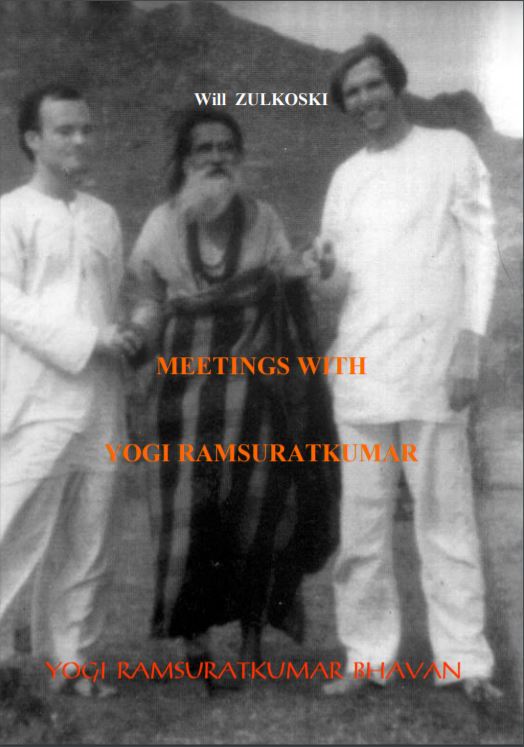
A biography by American Will Zulkowsky who with his wife Joan, lived for some time with Yogi Ramsuratkumar during the 1970’s.
OM, today is the start of a book entitled Meetings with Yogi Ramsuratkumar. The purpose of the book is to share my experiences and relate those of other people as well with Beloved Yogi Ramsuratkumar. Yogi Ramsuratkumar was called Swami by most of
the local people at the time I met Him in 1973. Uncle Sam was looking for warm bodies to fight in the war, but that whole notion was alien to the very time, the Vietnam War was really heating up and though, but in the how and why of creation. At the fortunately shared my interest in yoga, not hatha yoga school, i had a fascination for the yoga philosophy. While in grad school, I married my wife, Joan who Indiana University. After dropping out of graduate moved to Indiana in the sixties where I attended.
As a background, I grew up in West Virginia then fiber of my being. By God’s Grace, i received a conscientious objector status and worked in Indiana Univ. Medical Centre in Indianapolis for two years in lieu of the draft. At the time, I had a clerical job at the medical centre evening shift. I had plenty of time to read after my duties were finished and read ail of Sri Aurobindo’s works and Swami Vivekananda’s works that I could get my hands on. After working this dull job for two years, my wife who had taught grade school and i decided to go to India to meet the real saints.
Download:
http://yogiramsuratkumar.info/PDF/Will%20Zulkoski%20-%20Meetings%20with%20Yogi%20Ramsuratkumar.pdf
Om Pilgrim’s Companion To The Holy Kailas And Manasarovar: Swami Pranavananda
Swami Pranavananda’s first book, Pilgrim’s Companion to the Holy Kailas and Manasarovar was published in 1938.
Download:
https://archive.org/details/in.ernet.dli.2015.515397/mode/2up
Paramahansa Yogananda Comic
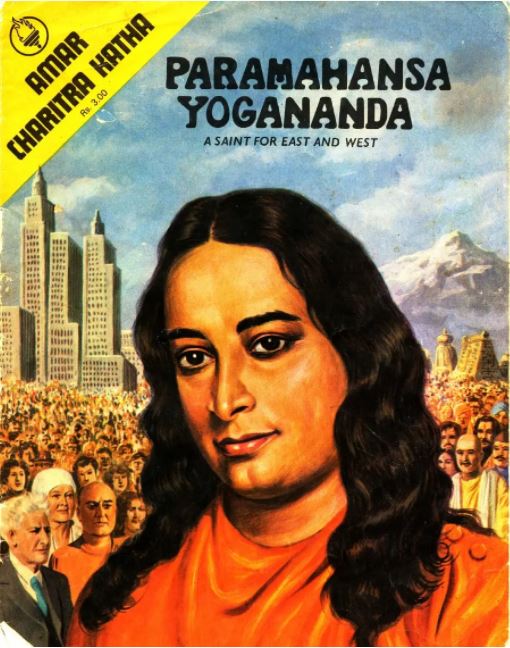
1982 comic book with script approved by the lnternational Publications Council of Self-Realization Fellowship/Yogoda Satsanga Society of India.
Mukunda Lal Ghosh was born in Gorakhpur on January 5, 1893. Great saints predicted that his life would be extraordinary. Even as a little boy, Mukunda had a religious bent of mind. At seventeen, he met his guru, Swami Sri Yukteswar Giri, through whose guidance Mukunda attained divine enlightenment. Sri Yukteswar gave him the sannyas name, Yogananda, and the title Paramahansa.
Although Yoganandaji wanted to live as a hermit, he submitted to the desire expressed by his Guru and his Paramparamguru, Mahavatar Babaji, that he should spread all over the world the ancient knowledge of Kriya Yoga: a spiritual science for realising God and making him a practical part of one’s life. To accomplish his mission, Yoganandaji founded in 1917 the Yogoda Satsanga Society of India. Later, in 1920, he established in America an international society called Self-Realization Fellowship. Yoganandaji’s sublimelove of God inspired reciprocal love in the hearts of others; he came to be known as Premavatar: an incarnation of divine love. He taught that all men can know God personally, and that this is the only lasting cure for human suffering. As one of India’s truly great spiritual masters, he did pioneering work abroad to establish a living link between East and West, and to demonstrate how vital it is for man to unite every action to the love and wisdom of God. India paid formal tribute to her great son on the 25th anniversary of his Mahasamadhi by issuing a commemorative postage stamp. This Amar Charitra Katha is based on Paramahansa Yogananda’s Autobiography of a Yogi, which is acclaimed all over the world as a classic in Yogic literature.
Download:
https://www.scribd.com/doc/156883424/117706004-Comic-Book-Paramhansa-Yogananda
Patanjali Yoga Sutras
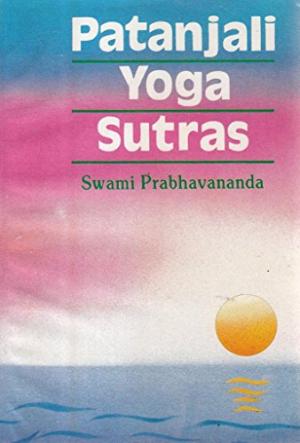
Patanjali (around 400 BC) – is the author of Patanjali Yoga Sutras.
The Yoga Sutras by Patanjali is a major work in yoga, this book is about control of mind and the true goal of yoga. The sutras are full of wisdom, and the translation in neat English makes it very easy for people to understand the ancient Sanskrit text. It starts with the birth and growth of spiritual man through the control of mind. In all, this is a “all in one” book for yoga philosophy written by the master himself.
Originally published by the Vedanta Society Southern California for the benefit of readers who do not know Sanskrit and yet are interested in Indian psychology which plumbs the depths of the human mind. Swami Prabhavananda has taken special pains in this book to present the philosophy and practice of Yoga in a non-technical up to date phraseology that can be understood and enjoyed by all enquiring minds.
Review by Vishwanath Iyer of Patanjali Yoga Sutras by Swami Prabhavananda – Patanjali Yoga Sutras by Swami Prabhavananda is a translation of a seminal work on Raja Yoga of Guru Patanjali. However, Swami Patanjali is a source of much speculation. Some say that he is also the author of a very respected book on Sanskrit grammar while others dispute this. Thus, it is possible that the Patanjali who wrote the book on grammar is different from the one who wrote on Yoga.
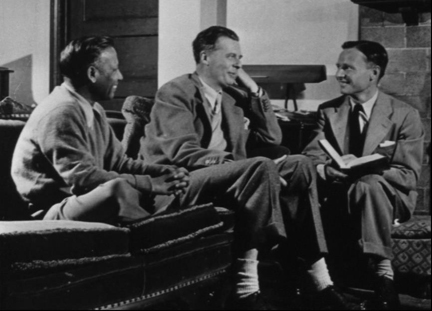
& Christopher Isherwood
This book or sutra (strand of verses) on Raja Yoga is split into 4 major chapters – first on liberation, second on practice, third on manifestation and fourth on isolation. The old Sanskrit of the book makes translation and understanding difficult. Also, the numerous translations have added to the confusion, so one should be careful during interpretation of the verses.
However, Patanjali Yoga Sutras are a “Must Read” for anyone seriously interested in progressing on Raja Yoga.
Swami Prabhavananda (December 26, 1893 – July 4, 1976) was born in India and joined the Ramakrishna Mutt after completing his graduation from Kolkatta University. After initiation, he moved to USA in 1923 to set up ashrams there. Under his administration, the Vedanta Society grew to be the largest such society in the West.
His translation of the Yoga sutras can be described as expansive. Swami Prabhavananda tends to expand the translation of the verses into related aspects of philosophy, sometimes not a directly related to the verse. So, one ends up reading the Sutras as an extension of Swami Prabhavananda’s own experiences with the truth; not necessarily as a direct translation of the Patanjali Yoga Sutras.
However, the commentaries are earthy and simple. So whether the book can be termed an accurate representation of the Patanjali Yoga Sutra or not, it a short, simple and effective primer on Yoga.
More on the Yoga Sutras of Patanjali
by Nadarajah
Download:
https://estudantedavedanta.net/Yoga-Aphorisms-of-Patanjali.pdf
Penthouse Of The Gods. A Pilgrimage into the Heart Of Tibet and the Sacred City of Lhasa: Theos Bernard

Theos Bernard is perhaps Tibet’s Lost Emissary to the West. An amazing, often overlooked man who brought Yoga and Tibetan culture to America. Theos Bernard’s colourful, enigmatic, and sometimes contradictory life captures an intersection of East and West that changed our world.
Theos Casimir Bernard (1908 – 1947) was an American scholar of Indic and Tibet religion, an accomplished practitioner of Yoga, and a pioneer of Indian and Tibetan studies in the United States. Bernard had a fascinating life of travel and adventure, and was only the third American to visit Lhasa. In this 1939 book Penthouse of the Gods he recounts his travels in 1937 through Tibet to the forbidden holy city of Lhasa and his experiences there, including his embrace of Buddhism and initiation into the Buddhist priesthood.
After years of forcibly stopping foreigners at the borders, the leaders of Tibet opened the doors to their kingdom for Theos Bernard. He was the first American ever initiated into Tantric practices by the highest Lama in Tibet. He spoke Tibetan, wore Tibetan attire, boarded with a Tibetan nobleman for three months, visited the great monasteries and temples, and met important dignitaries, ambassadors, and officials. He did not however, meet with the Dalai Lama.
This fantastic account is unparalleled in its detail and authenticity, and offers a glimpse into a place and time completely unrecognisable from the Tibet of today.
When Bernard left, he was sent home with fifty mule loads of priceless, essential Buddhist scriptures from government and monastery vaults. He brought these writings to America, where he achieved celebrity as a spiritual master. The charismatic and controversial “White Lama” introduced a new vision of life and spiritual path to American culture before mysteriously disappearing in the Himalayas in 1947. Presumed murdered on his way to a Tibetan monastery in a remote area of the Indian Himalaya.
Together with his third wife, Helen Graham Park, he returned to India in 1947, this time seeking rare manuscripts from the Key Monastery in the hills of Spiti near Ladakh. Entering the Punjab in what is now Pakistan, en route to his destination, his party of Muslim porters was rumoured to have been attacked by Lahouli tribesman, shot and their bodies thrown into a river.
Helen Graham Park reported later on arrival in Delhi, that shepherds had told her of seeing Lahouli tribesmen attack her husband’s party and kill his porters (sometime between September 12th and 14th). The party at the time was short of food and she feared that he might also have lost his heavy clothing to the raiders. Bernard had set out on August 20 from the out-of-the-way Kulu Valley of the northern Punjab. Six days after that, Hindu-Moslem rioting broke out in the valley and she herself had to flee 124 miles on foot southward to Simla. She passed through New Delhi on the way to Calcutta, where she would await word of her husband.
Conflicting reports about his whereabouts circulated for several months, and though his wife waited for him in Calcutta, he never returned as eventually he was declared dead, though his body was never found.
Download:
https://archive.org/details/in.ernet.dli.2015.75734
Theos Bernard – The American Explorer of Tibet. By Pastor Niral Patel | October 16, 2017
White Lama: The Life of Tantric Yogi Theos Bernard, Tibet’s Lost Emissary to the New World by Douglas Veenhof
Pilgrimage in Tibet
1998. Edited by Alex McKay.
Download:
https://pahar.in/?wpfb_dl=22170
Ramana Periya Puranam (Inner Journey of 75 Old Devotees): V. Ganesan
https://www.aham.com/RamanaPeriyaPuranam/RamanaPeriyaPuranam.pdf
Sacred Groves of Sikkim
Sikkim, one of the smallest states of India with a total geographical area of 7096 km. Sikkim has many sacred areas with religious and/or historical backgrounds. All the sacred groves are attached to the local monasteries (Gumpas), dedicated to the deities and managed by the Gumpa authority or Lamas, or often by the village community. Out of many sacred groves found in Sikkim only 19 of the sacred groves are presented in this report.
Download:
Sanjeevini

About the Sai Sanjeevini Healing Prayers System;
Sanathana Sai Sanjeevini healing fragrances is a prayer based, self-learning spiritual healing system to awaken the inherent healing power and wisdom of every being. The healing system is offered with all humility, deep gratitude and selfless unconditional love for the wholistic well-being of the Lord’s entire creation in all the realms, irrespective of caste, colour, creed, language, gender, religion and nationality.
The book A Healer’s Guide on Sai Sanjeevini healing is a complete self-learning Guide. To know more about the Contents of A Healer’s Guide or to Browse or Download the Guide, please click on the link below:
Download:
https://www.saisanjeevini.org/index.php
Selected Early Works of Paramhansa Yogananda
Download:
The Complete Works of Sri Aurobindo
The Complete Works of Sri Aurobindo in one PDF (35 volumes, 15,000 pages), to make it easier for readers who would prefer Aurobindo’s entire written work in one file.
Download:
The Complete Works of Swami Vivekananda
The entire collection in 9 volumes, about 5,000 pages.
Download:
The Hunza
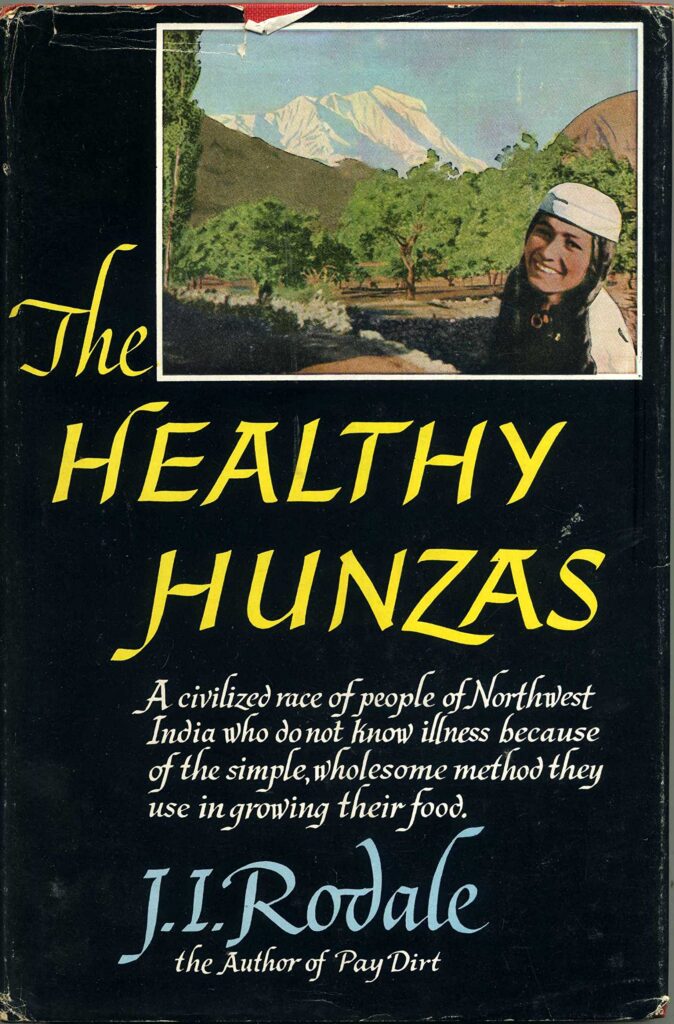
The Healthy Hunzas.
Jerome Irving Rodale (1898 – 1971) was a publisher, editor, author, playwright, and founder of Rodale, Inc. He was an early advocate of sustainable agriculture and organic farming in the United States. As an author, his work included several magazines and books, including books featuring different authors, on the subject of health. He popularised the term “organic” as a term for growing food without pesticides.
J. I. Rodale writes in introduction – “The Healthy Hunzas is based on the work of many authors who wrote about the Hunzukuts. Most of these writers actually visited the Hunza country and thus can speak from the authority of personal experience and observation. Others accumulated data from books as well as from conversations with persons who had been there. For example, Sir Albert Howard and Dr. Wrench interviewed and visited with the Lorimers and Sir Robert McCarrison on different occasions. When the desire to secure information about Hunza took on the challenging nature of an idée fixe with me, I sent out calls to book-dealers all over the world. Though a volume they might have had in their possession contained only a single paragraph relevant to my purpose, I nevertheless purchased it. 1 believe, therefore, that I have seen practically everything that was ever published in English about this fabulous people. The bibliography at the end of this book contains only a partial list of the most detailed and informational of this Hunza collection now in my library.”
Download:
https://www.soilandhealth.org/wp-content/uploads/02/0203CAT/020302rodale/020302intro.html
Hunza is a remote feudal community lost in the backdrop of the Himalyas. On the old caravan route from India to Tibet and on to Cathay. Many of the locals are descendants of the soldiers of Alexander the Great. Marco Polo would have travelled this way on his journeys of exploration. This film, made in the 60’s shows Hunza as almost a closed community with little or no crime, no need for money, no shops, no hotels – is this still the same now?
Hunza 1957 | Search for Paradise.
This historic travelogue Search for Paradise is a 1957 American documentary film in “Cinerama” technique about Kingdom of Hunza, a hidden valley bordered by China, Russia, India, Pakistan and Afghanistan, home to a legendary warrior tribe.

https://www.youtube.com/watch?v=SRHywnX7C5o
History of the Natural and Organic Foods movement (1942 – 2020).
Download:
https://www.soyinfocenter.com/pdf/224/NaFo.pdf
The Mysterious Kundalini: Vasant G Rele
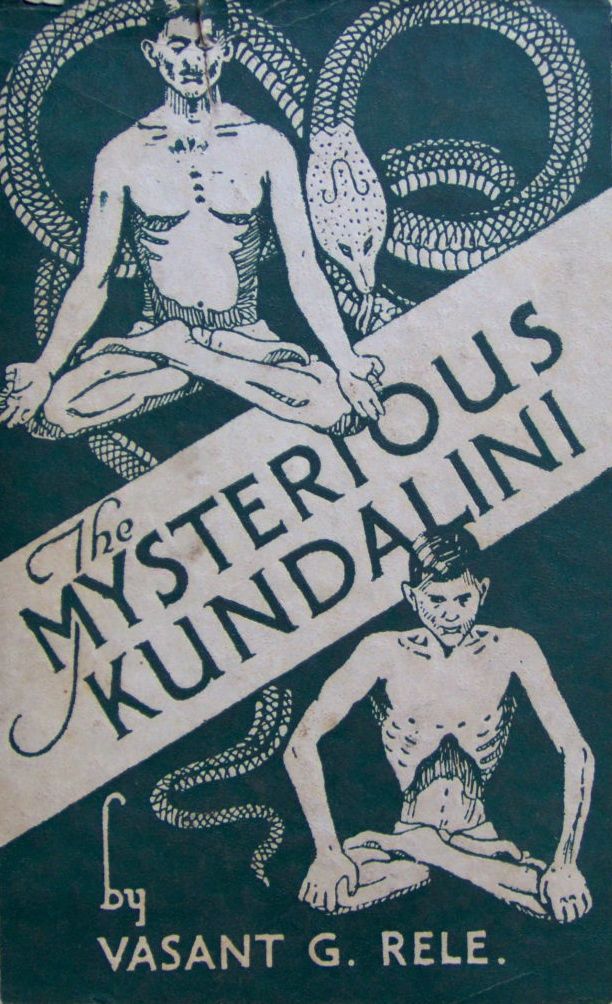
This book was first introduced as a paper read before the Bombay Medical Union in 1926. It was so well received that encouragement was given to publish the paper as a book for those interested in “the science of Yoga.” In this work, the author attempts to give a physiological explanation of the powers which the Yogis attain by their methods.
Shelli Joye (California Institute of Integral Studies, Philosophy, Cosmology, and Consciousness, Post-Doc) writes;
My own interest in this book stems from having acquired it forty years ago, prior to leaving New York to begin graduate studies in Indian Philosophy in 1974 at the California Institute of Asian Studies in San Francisco. Having completed an undergraduate engineering program of studies, I was impressed by the fact that Dr. Vasant Rele, author of The Mysterious Kundalini, had the scientific training of a physician, and even more so by his carefully detailed pen and ink diagrams with which he backed up his theory of a physiological basis of the phenomena associated with Kundalini Yoga. This encouraged me to include visualization of anatomically correct internal components during meditation on the various chakra loci within my own body, which I believe has greatly enhanced my own experience of yogic contemplation over the intervening years.
The book contains ten chapters, with titles that well describe the progression of material:
INTRODUCTION
I. SCIENCE AND PHILOSOPHY OF YOGA
II. YOGA PRACTICES
III. TANTRIC ANATOMY OF NERVES: NADIS, CHAKRAS, SHAKTIS
IV. KUNDALINI – ITS LOCATION AND FUNCTIONS
V. KUNDALINI IDENTIFIED WITH RIGHT VAGUS NERVE
VI. PANCHA PRANAS AND PANCHA VAYUS
VII. AWAKENING OF KUNDALINI BY BANDHA PROCESSES
VIII. AWAKENING OF KUNDALINI BY MUDRA PRACTICES
IX. ASHTA SIDDHIS
X. SUMMARY
Review by Shelli Joye https://www.academia.edu/3717872/Review_of_The_Mysterious_Kundalini_by_Dr_Vasant_Rele?email_work_card=view-paper
Download:
https://ia803203.us.archive.org/26/items/TheMysteriousKundalini/The%20Mysterious%20Kundalini.pdf
The Power-places of Central Tibet. The Pilgrim’s Guide: Keith Dowman

A hands-on guide to pilgrimage in Central Tibet, following the 19th century route of Khyentse The Great.
This pilgrim’s guide to the power places of Central Tibet is based upon Guide to the Holy Places of Central Tibet by Jamyang Khyentse Wangpo a 19th century pilgrim.
I spent the summers of 1985-87 wandering about Central Tibet visiting the pilgrimage destinations mentioned by the august Khampa pilgrim Jamyang Khyentse Wangpo, in his Tibetan guidebook.
This book, The Power Places of Central Tibet: The Pilgrim’s Guide is the result of that arduous trip in which trekking, hitch-hiking, tractor rides, horse riding and even a goat ride all moved me on. During those years rebuilding of the gompas was progressing fast and althought the desolation of the ruins and paranoia of the people was still evident it was an exciting time to be in Tibet.
Researching the Guide was a ground breaking exercise as few Europeans had been off the main highways and I was the first foreigner to enter some valleys. The book remains a milestone in the history of pilgrimage in Tibet.
‘For those visitors to Tibet with time to visit the more remote temples and caves The Pilgrim’s Guide is indispensable. It is written in a style that is accessible to the interested layman as well as the Buddhist scholar.’
A.B.Rowe in the Geographical Journal.
Contents of Power Places of Central Tibet
Preface
Introduction
- The Yoga of Pilgrimage
- The Condition of the Gompas
- ‘The Western Storehouse’
- An Outline of the History of Central Tibet
- The Schools of Tibetan Buddhism
Notes on Pronunciation and Tibetan Names
Note on Cartography
Glossary of Geographical Terms and Key to Maps
1 The Holy City of Lhasa
2 The Caves of Drak Yerpa
3 North of Lhasa to Reteng
4 To Ganden and Beyond
5 The Drigung Mandala
6 Tolung: The Karmapa’s Domain
7 The Highway from Lhasa to Chaksam Bridge
8 Below Lhasa to Simpo Ri
9 The South Bank of the Tsangpo
10 The Upper Dranang and Drachi Valleys
11 Yarlung: The Heart of Tibet
12 Chongye and the Royal Tombs
13 Dorje Drak and the Caves of Drakyul
14 Samye Chokor
15 The Valley of Yon
16 Sangri and The Woka Valley
17 Dakpo and Lhamo Latso
18 Across Tsang to the Nepal Border
Appendixes
I The Supine Demoness
II Guru Rimpoche’s Cave Power-places
III Power-places with Treasure Troves
IV The Lume Temples
V Some Principal Kadampa Gompas
VI The Original Kagyu Gompas
Notes to the Text
Glossary of Tibetan Terms
Visual Glossary of Buddhas
Index
Download:
http://promienie.net/images/dharma/books/dowman_power-places-of-central-tibet.pdf
The Secret Teachings of All Ages: Manly P. Hall
Third Eye and Kundalini (An Experiential Account of Journey from Dust to Divinity): B S Goel
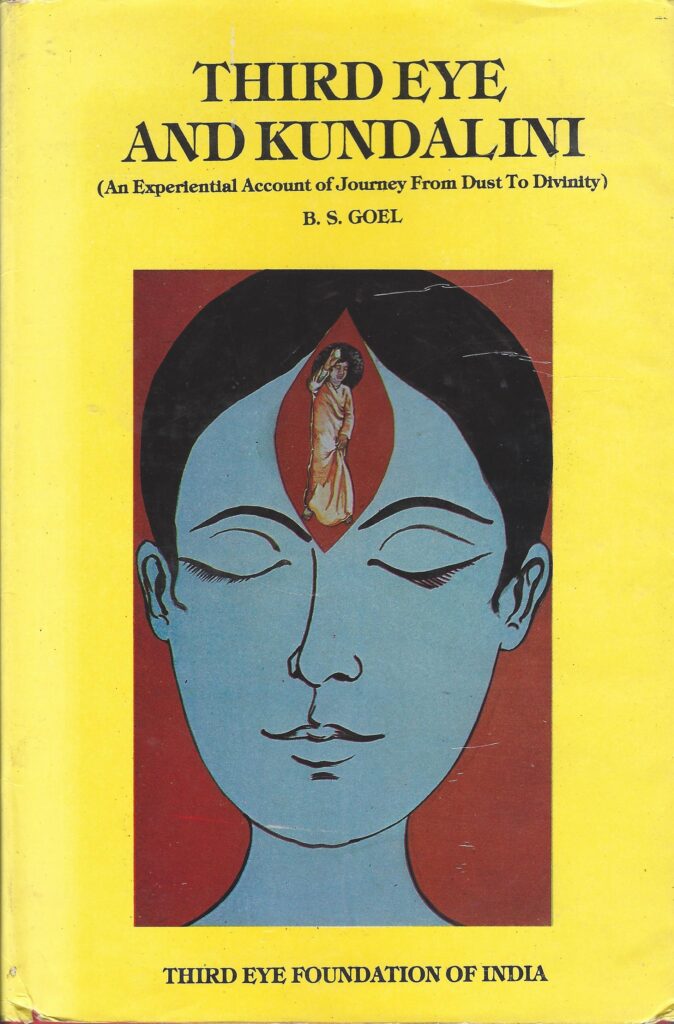
Third Eye and Kundalini is one of the most sensational accounts of the transformation of Dr. B.S. Goel from dust to divinity from mortality to immortality and from nothingness to everything.
It contains firsthand experience of Third Eye which are perhaps not available in any modern writing presented in modern times on the subject.
Bi-Ma writes, “The topic of Kundalini is generally very confusing, suppressed or unknown within the western civilization. I had absolutely no information about this natural but often dramatic phenomenon until 1987 when I for the first time visited India and found a book named Third Eye and Kundalini by Dr. B.S ,Goel. This book clarified very much about what I had “struggled” enormously to understand and deal with; what spontaneously and very dramatically happened to me already eleven years earlier, in 1976; an intense Kundalini awakening.” cosmoholism.com
Download:
Three Years in Tibet
Review by Bariloche: Everyone should read this book. Especially those with an interest in Tibet. In 1897 a Japanese Buddhist Monk left Japan to walk into Tibet to gather Buddhist Scriptures and learning.
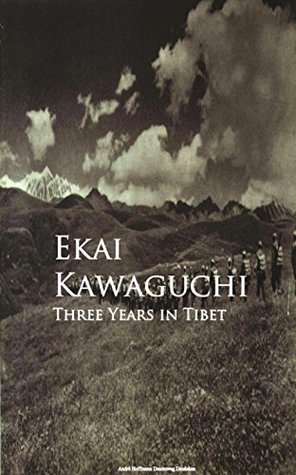
He first went to India to learn to speak Tibetan and then after some years, he walked into Tibet, avoiding the usual checkpoints. He had to do this because generally the penalty for incursion into Tibet was death – to that person and everyone who helped them.
His account of the journey was nothing short of miraculous. His route was the highest and most difficult and the stories of how he survived leave you breathless. He survived on practically no food and on one frozen occasion, he kept himself alive overnight in the winter in inadequate clothing by meditating.
Eventually he bluffs his way in and is admitted to a monastery where he begins study and eventually, although he is not a doctor, he establishes a reputation as a skilled doctor by reason of his skills which are far better than the local doctors – in fact, he believes the best advice in Tibet is to avoid their doctors if you want to live. He even becomes physician to the Dalai Lama.
He remained there 3 years observing every thing around him. His descriptions of local society, religion, customs, marriages, funerals, appointment of Lamas including the Dalai Lama, government, punishment, ignorance, superstition, cleanliness (or the opposite) and practically everything else you could think of (including the relationship with China) is fascinating and a must-read for anyone wanting to understand the present situation with China and the world.
I first borrowed a first edition of this book and went back to borrow it so many times that I finally decided that I had to own a copy of my own. So should you.
Review by Pall Mall: Three Years in Tibet is an important and inadvertently hilarious book. Kawaguchi was a Japanese Buddhist scholar; his fastidious and serious disposition is immediately apparent, and at complete odds with the environment in which he found himself. I’ve read most of the available accounts of travellers in Tibet that have been written since the mid-1800’s. This book shines due to its lack of sentimentality. Kawaguchi’s Tibet is plagued with filth, less than perfect monks, and customs that he finds abhorrent. He gets lost and robbed. In one, somehow incredibly amusing, passage he ends up near tears and almost freezing to death in the company of two bleating sheep. In great detail, he describes the customs and culture, as well as the details of life in the Lhasa region. He was able to pass as Chinese, and therefore was able to live freely in the city – visitors from other foreign nations were deported. The book is almost 700 pages long, but it is so interesting, informative, and engaging that I didn’t want it to end. The only reason which I can think of that this book isn’t more talked about is that it does not fit in with the currently popular mythologized version of Tibet as a homogenous utopia. This is unfortunate, as the portrait that Kawaguchi paints is of a very real and diverse society. I strongly recommend this book to anyone who is interested in Tibet, Tibetan Buddhism, China, or travel writing. It is also chock full of information useful to historians and other scholars. Best of all, it is an easy and delightful read.
Download:
https://www.gutenberg.org/files/52594/52594-h/52594-h.htm
Tibet: A Handbook
1975 Handbook by Helmut Hoffman in collaboration with Stanley Frye, Thubten J. Norbu and Ho-chin Yang
Download:
https://pahar.in/?wpfb_dl=21813
Tibet Handbook
By Victor Chan, fully illustrated throughout, this comprehensive 1994 guide to Tibet contains 1,200 pages of meticulously detailed itineraries, fascinating descriptions, helpful advice, and eye-opening illustrations. 250 maps.
Download:
https://pahar.in/?wpfb_dl=22694
Tibetan Medicinal Plants
An Illustrated Guide to Identification and Practical Use by Dr. Tenzin Dakpa and Bhuchung D. Sonam.
Download:
https://pahar.in/?wpfb_dl=22111
Tibetan, Nepalese, Indian Art
Download:
Turn Eastwards: Pascaline Mallot
the French writer’s 1938 book Turn Eastwards was appreciated by Sri Ramana. In the second edition of Self Realization by B. V. Narasimha Swami included a short excerpt from a book entitled Turn Eastwards by Pascaline Mallet who visited the ashram in 1937. For reasons unknown, this excerpt was deleted from the subsequent editions; In May 1938, Bhagavan Ramana, after having gone through the whole book of Mme. Pascaline Mallet’s book Turn Inwards, spoke for about an hour on that book. He said that the writing was full of feeling and the writer was sincere. The book is written in a simple style and finishes off with remembrance of Himself. Bhagavan Ramana thinks that the book was well written. He interprets ‘Turn Eastwards’ as ‘Turn to the Source of Light.’
Download:
https://archive.org/details/dli.csl.6279/page/n191/mode/2up
Download:
https://media.ashrama.org/1489425989
Vahini
The Vahinis, written by Sri Sathya Sai Baba (translated into English).
Proffessor Kasturi collated all the articles that Sathya Sai Baba had written for the Sanathana Sarathi, the ashram periodical, into a book form known as the Vahini Series, as Baba used to title all of his articles as ‘Vahinis.’ Vahini meaning flow or stream.
There are 15 Vahinis in all, written in Telugu by Baba and translated into English by Proffessor Kasturi. Their simplicity, which, at the same time, contains such a depth of meaning, is unique. They speak of Peace, Meditation, Love and Wisdom. They seek to acquaint the reader with the Upanishads and the Gita.
Proffessor N Kasturi writes “Baba decided on a small book on the Upanishads, the Upanishad Vahini, in order to rivet the world to the efficacy of Vedanta. As editor of the magazine, which published serially the chapters of this book, I had an amazing experience, every month. After dispatching the magazine on the 16th of every month, I would go to him for the next part of the series. Announcing the name of the Upanishad Himself, He would ask me to wait for a while in His room and proceed along the verandah with a notebook and pen, towards the room where they stood a table with a chair by its side and nothing else besides.
Once, it was the turn of the Brihadaranyaka Upanishad, to be summarised and simplified. It is the biggest and the profoundest of the ten. I am certain that Baba had never read it or consulted others who could talk on it. And there was no copy available anywhere within miles. But forty minutes after he moved out with a pen and the notebook as His sole possessions, I could descend the eighteen steps from His room with a ten-page dissertation on the truths this Upanishad enshrined! I peeped into the script as I walked towards the Press and my eyes fell on the Telugu words, which said, ‘the grandeur of the intellect of Sage Yajnavalkya is impressively evident in this Upanishad’. I told myself, the grandeur of the Omniscient teacher that Baba is, is now impressively evident to me.”
Prema Vahini – The Stream of Divine Love. To read and download: Click here.
Dhyana Vahini – The Practice of Meditation. To read and download: Click here.
Dharma Vahini – The Path of Virtue and Morality. To read and download: Click here.
Jnana Vahini – The Stream of Eternal Wisdom. To read and download: Click here.
Gita Vahini – The Divine Gospel. To read and download: Click here.
Prashanthi Vahini – The Supreme Bliss of the Divine. To read and download: Click here.
Sathya Sai Vahini – Spiritual Message of Sri Sathya Sai. To read and download: Click here.
Ramakatha Rasa Vahini – The Sweet Story of Rama’s Glory. To read and download: Part 1: Click here. Part 2: Click here.
Sandeha Nivarini – Clearance of Spiritual Doubts. To read and download: Click here.
Leela Kaivalya Vahini – The Cosmic Play of God. To read and download: Click here.
Sutra Vahini – Analytical Aphorism on Supreme Reality. To read and download: Click here.
Vidya Vahini – Flow of Spiritual Education. To read and download: Click here.
Upanishad Vahini – Essence of Vedic Knowledge. To read and download: Click here .
Bhagavatha Vahini – The story of the Glory of the Lord. To read and download: Click here.
Prasnothara Vahini – Answers to Spiritual Questions. To read and download: Click here.
Download:
http://www.sssbpt.info/english/vahinis.html
https://www.srisathyasai.org/pages/sai-his-messages-writings.html
Vedanta Shastras Library
Adi Sankara ↣ Bhaja Govindam
Adi Sankara ↣ Brahma Jnanavali Mala
Adi Sankara ↣ Dasa Sloki or Nirvana Dasakam
Adi Sankara ↣ Maneesha Panchakam
Adi Sankara ↣ Maya Panchakam
Adi Sankara ↣ Nirvana Shatkam
Adi Sankara ↣ Prata Smarana Stotram
Adi Sankara ↣ Sata Sloki
Adi Sankara ↣ Shiva Manasa Puja
Adi Sankara ↣ Svarupanusandhana Ashtakam
Adi Sankara
Articles & Summary ↣ Khyati Vada
Articles & Summary ↣ Sama Veda: An Introduction
Articles & Summary ↣ Vidhi: Vedic Injunctions
Articles & Summary ↣ Works of Swami Samarpanananda
Articles & Summary
Bhagavad Gita
Brahma Sutra ↣ Brahma Sutra Adhyasa Bhashya
Brahma Sutra ↣ Brahma Sutra Lectures
Brahma Sutra
Carnatic Music Krithis
Jiddu Krishnamurti ↣ Art of Listening
Jiddu Krishnamurti ↣ Awakening of Intelligence
Jiddu Krishnamurti ↣ Beyond Violence
Jiddu Krishnamurti ↣ Biography of J. Krishnamurti [Excerpts]
Jiddu Krishnamurti ↣ Choiceless Awareness
Jiddu Krishnamurti ↣ Commentaries on Living [1]
Jiddu Krishnamurti ↣ Commentaries on Living [2]
Jiddu Krishnamurti ↣ Commentaries on Living [3]
Jiddu Krishnamurti ↣ Ending of Time
Jiddu Krishnamurti ↣ Exploration Into Insight
Jiddu Krishnamurti ↣ First and Last Freedom
Jiddu Krishnamurti ↣ Flame of Attention
Jiddu Krishnamurti ↣ Flight of the Eagle
Jiddu Krishnamurti ↣ Freedom From the Known
Jiddu Krishnamurti ↣ From Darkness to Light
Jiddu Krishnamurti ↣ Future Is Now
Jiddu Krishnamurti ↣ Future of Humanity
Jiddu Krishnamurti ↣ Impossible Question
Jiddu Krishnamurti ↣ Journal
Jiddu Krishnamurti ↣ Krishnamurti on Education
Jiddu Krishnamurti ↣ Krishnamurti to Himself
Jiddu Krishnamurti ↣ Life Ahead
Jiddu Krishnamurti ↣ Meditations
Jiddu Krishnamurti ↣ Mind of J. Krishnamurti [Excerpts]
Jiddu Krishnamurti ↣ Mind Without Measure
Jiddu Krishnamurti ↣ Mirror of Relationship
Jiddu Krishnamurti ↣ Network of Thought
Jiddu Krishnamurti ↣ Notebook
Jiddu Krishnamurti ↣ Only Revolution
Jiddu Krishnamurti ↣ Questions and Answers
Jiddu Krishnamurti ↣ Think on These Things
Jiddu Krishnamurti ↣ Tradition and Revolution
Jiddu Krishnamurti ↣ Truth and Actuality
Jiddu Krishnamurti ↣ Urgency of Change
Jiddu Krishnamurti ↣ Way of Intelligence
Jiddu Krishnamurti ↣ What Is Right Action?
Jiddu Krishnamurti ↣ Wholeness of Life
Jiddu Krishnamurti ↣ Wholly Different Way of Living
Jiddu Krishnamurti ↣ World of Peace
Jiddu Krishnamurti ↣ You Are World
Kanchi Maha Periyava ↣ Voice of God [Deivathin Kural] [Volume-1]
Lessons on Vedanta ↣ Bhagavad Gita
Lessons on Vedanta ↣ Panchadashi
Lessons on Vedanta ↣ Path to Joyful Living – Jeeva Yatra
Lessons on Vedanta ↣ Path to Joyful Living – Sadhana Panchakam
Mantras and Rituals
Moral Stories ↣ Panchatantra Tales
Nisargadatta Maharaj ↣ I Am That
Nisargadatta Maharaj ↣ I Am That [Spanish]
Nisargadatta Maharaj ↣ Nisargadatta Gita
Prayer Hymns – Stotras: Ayyappa
Prayer Hymns – Stotras: Devi ↣ Kaalika Ashtakam
Prayer Hymns – Stotras: Devi ↣ Mahishasura Mardini Stotram
Prayer Hymns – Stotras: Devi
Prayer Hymns – Stotras: Ganesha
Prayer Hymns – Stotras: Hanuman
Prayer Hymns – Stotras: Nava Grahas
Prayer Hymns – Stotras: Other ↣ Guru Gita
Prayer Hymns – Stotras: Other
Prayer Hymns – Stotras: Shiva ↣ Shiva Samhita
Prayer Hymns – Stotras: Shiva ↣ Thiruvasagam [Mannikkavasagar]
Prayer Hymns – Stotras: Shiva ↣ Tirumantiram [Saint Tirumular]
Prayer Hymns – Stotras: Shiva
Prayer Hymns – Stotras: Subrahmanya
Prayer Hymns – Stotras: Vishnu ↣ Guruvayurappan Stotras
Prayer Hymns – Stotras: Vishnu
Ramana Maharshi ↣ I Am (K)Not the Body
Ramana Maharshi ↣ Who Am I
Ramayanam ↣ Sundara Kandam: Hanuman’s Odyssey
Ramayanam ↣ Valmiki Ramayanam
Sri Ramakrishna ↣ Gospel of Sri Ramakrishna
Sri Ramakrishna ↣ Sri Sri Ramakrishna Kathamrita – Vol-1
Sri Ramakrishna ↣ Sri Sri Ramakrishna Kathamrita – Vol-2
Sri Ramakrishna ↣ Sri Sri Ramakrishna Kathamrita – Vol-3
Sri Ramakrishna ↣ Sri Sri Ramakrishna Kathamrita – Vol-4
Sri Ramakrishna ↣ Sri Sri Ramakrishna Kathamrita – Vol-5
Sri Ramakrishna ↣ Tales and Parables of Sri Ramakrishna
Sri Sarada Devi ↣ Gospel of Holy Mother Sarada Devi
Stories and Anecdotes
Swami Ramdas ↣ In Quest of God
Swami Ramdas ↣ In the Vision of God
Swami Vivekananda ↣ Complete Works of Swamiji – Vol-1
Swami Vivekananda ↣ Complete Works of Swamiji – Vol-2
Swami Vivekananda ↣ Complete Works of Swamiji – Vol-3
Swami Vivekananda ↣ Complete Works of Swamiji – Vol-4
Swami Vivekananda ↣ Complete Works of Swamiji – Vol-5
Swami Vivekananda ↣ Complete Works of Swamiji – Vol-6
Swami Vivekananda ↣ Complete Works of Swamiji – Vol-7
Swami Vivekananda ↣ Complete Works of Swamiji – Vol-8
Swami Vivekananda ↣ Complete Works of Swamiji – Vol-9
Swami Vivekananda ↣ Patanjali Yoga Sutras
Upanishads ↣ Other Upanishads
Upanishads
Vedanta Books – Other ↣ Atma Vidya Vilasa [Devanagari]
Vedanta Books – Other ↣ Hastamalakiyam
Vedanta Books – Other ↣ Jeeva Yatra [Devanagari]
Vedanta Books – Other ↣ Jeeva Yatra [Tamil]
Vedanta Books – Other ↣ Laghu Yoga Vasishta
Vedanta Books – Other ↣ Sanatsujatiyam
Vedanta Books – Other ↣ Yoga Vasishta
Vedanta Books – Other ↣ Yoga Vasishta Sara
Vedanta Books – Other
Vedas ↣ Atharva Veda
Vedas ↣ Krishna Yajur Veda [Katha Aranyaka]
Vedas ↣ Krishna Yajur Veda [Kathaka Brahmana]
Vedas ↣ Krishna Yajur Veda [Taittiriya Brahmana]
Vedas ↣ Krishna Yajur Veda [Taittiriya Samhita]
Vedas ↣ Rig Veda [Ashtaka]
Vedas ↣ Rig Veda [Mandala]
Vedas ↣ Sama Veda [Kauthuma Samhita]
Vedas ↣ Sama Veda Samhita
Vedas ↣ Shukla Yajur Veda Samhita
Vedas and Vedic Hymns
Vedic Hymns ↣ Agni Suktam
Vedic Hymns ↣ Devi Suktam [Vaak Sutam]
Download:
https://www.shastras.com/downloads/
Vimana
According to early Sanskrit texts the ancients had several types of airships called vimanas. Like aircraft of today, vimanas were used to fly through the air from city to city; to conduct aerial surveys of uncharted lands; and as delivery vehicles for awesome weapons.
Download:
https://holybooks-lichtenbergpress.netdna-ssl.com/wp-content/uploads/The-Vimanika-Shastra.pdf
Yoga for Americans: Indra Devi (1959) 1968 Print
Yoga Guru Tat Wale Baba, Rishi of the Himalayas: Vincent J Daczynski
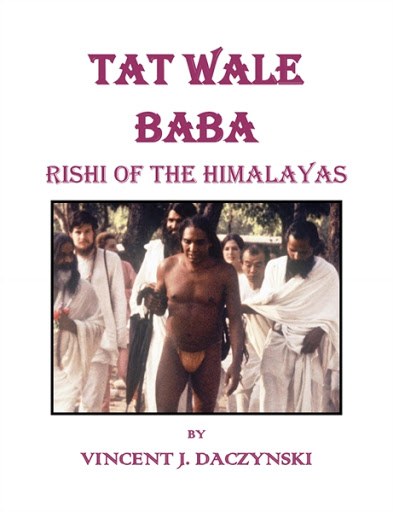
According to Vedic scripture, the mere sight of a yogi saint is sufficient to transform an individual’s life from the pursuit of mundane pleasures to the pursuit of wisdom and god-realisation. My personal experience bears truth to this statement. I was profoundly influenced by the sight of Sri Tat Wale Baba, and my brief two hours’ encounter with him. Sri Tat Wale Baba was the living embodiment of the Vedas.
He did not have to speak or preach. He exhibited those qualities about which other yogis only preach. His presence radiated a divine essence that, of itself, communicated the goal of life to all who had the honor to come within his aura. This book was written out of my deep admiration and respect for Sri Tat Wale Baba. It is a tribute to one of the world’s greatest twentieth-century yogis who, because of his reclusive life-style, has received little publicity outside of India. It is the intent of this book to memorialise Sri Tat Wale Baba for the many people who knew and loved him. Of further intent is to introduce the Western world and all seekers of God to Sri Tat Wale Baba so that they might glimpse (albeit in book format) the life of an enlightened yogi.
Download:
http://mmy.klemke.de/M2000006.pdf
Yogis, Ayurveda, and Kayakalpa. The Rejuvenation of Pandit Malaviya: Suzanne Newcombe
Tapaswiji Maharaj lived for 185 years from 1770 to 1955. Born as the prince of Patiala, he performed decades of austere penance and used the ancient Vedic technique of rejuvenation, kaya-kalpa treatment three times to regain his youth. During his long life he travelled all across India imparting spiritual wisdom to innumerable seekers of truth and healing the sick and needy.
Download:
https://oro.open.ac.uk/54122/1/29-Article%20Text-356-5-10-20180323.pdf
By Andrea Pflaumer:
https://www.jyotish.ws/wisdom/kaya_kalpa_immortality.html
The Man From UNCLE : The Calcutta Affair


